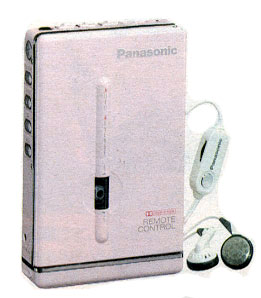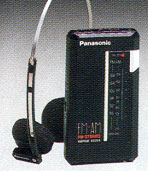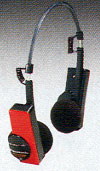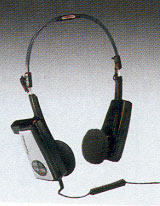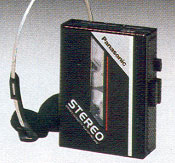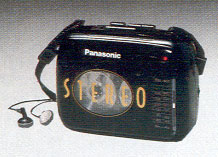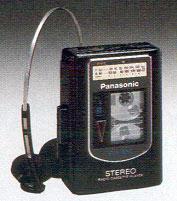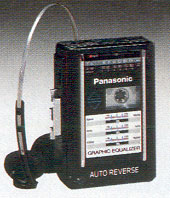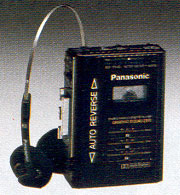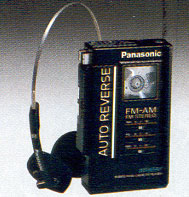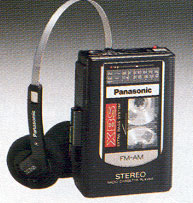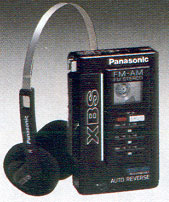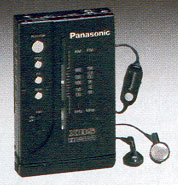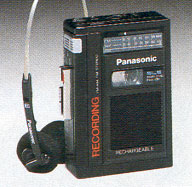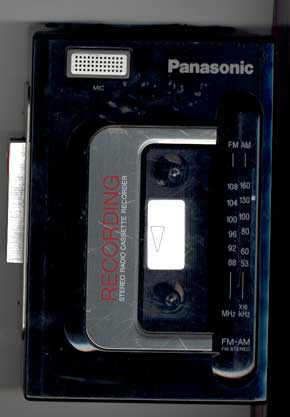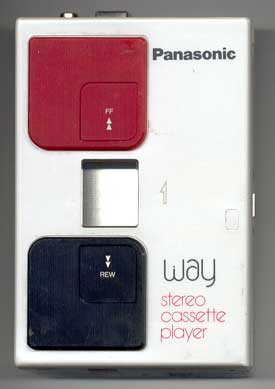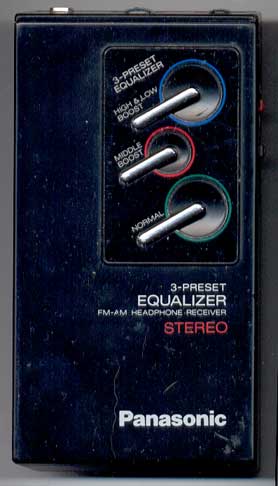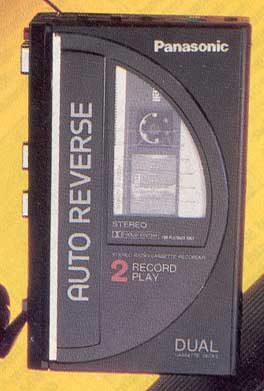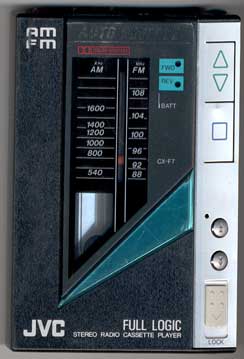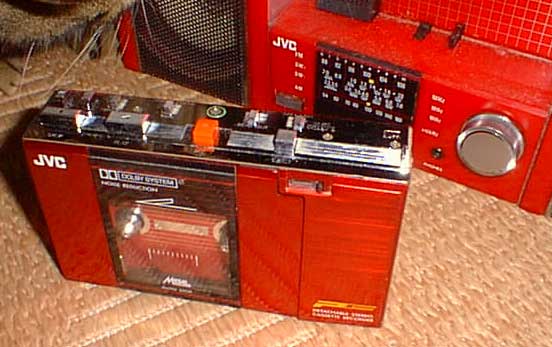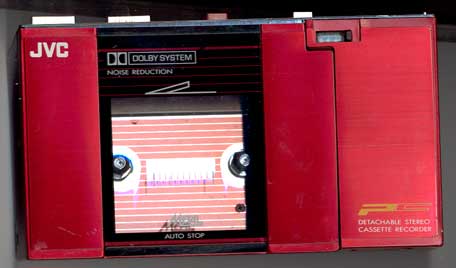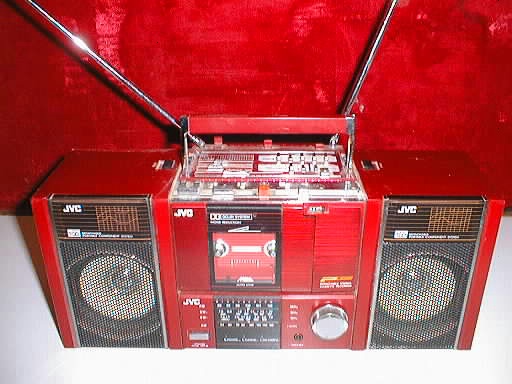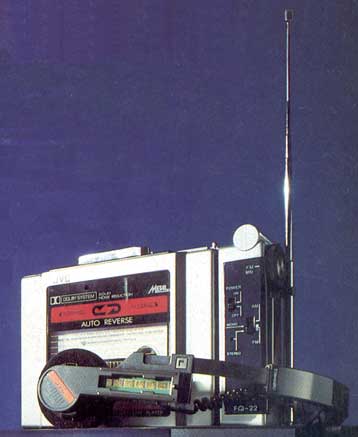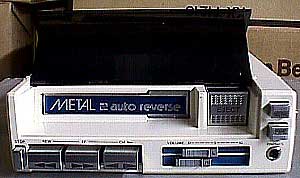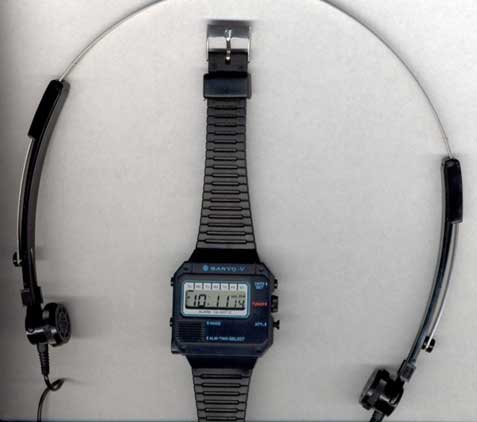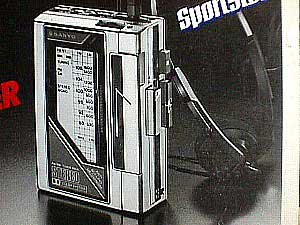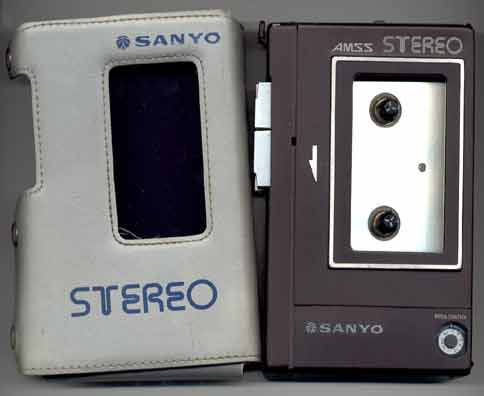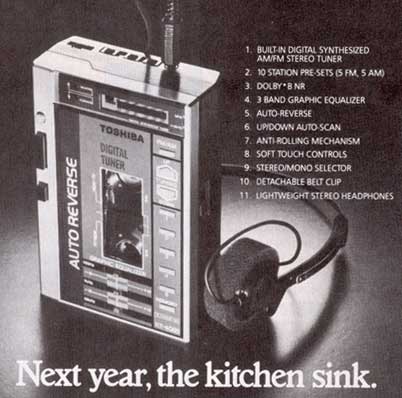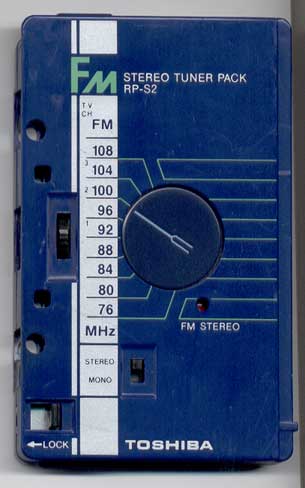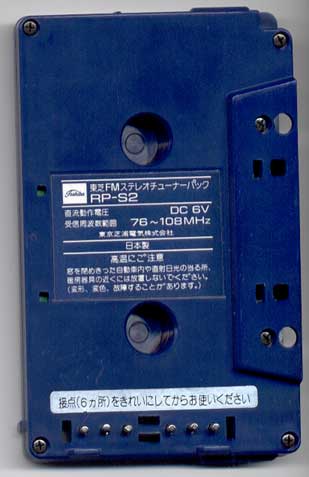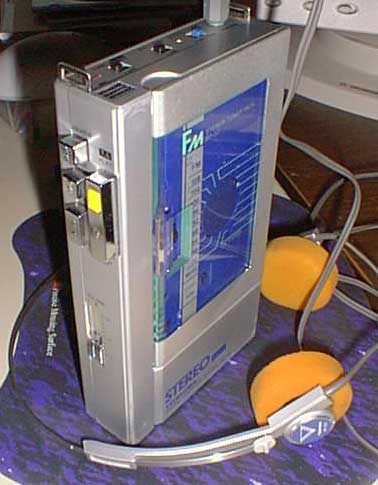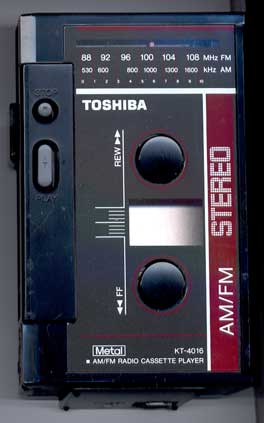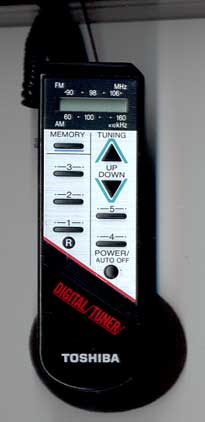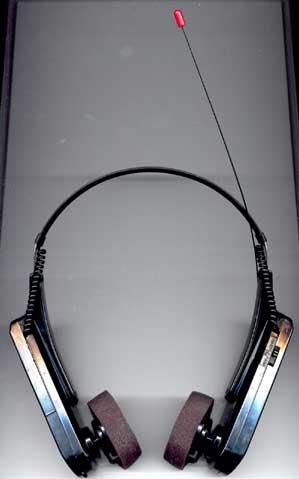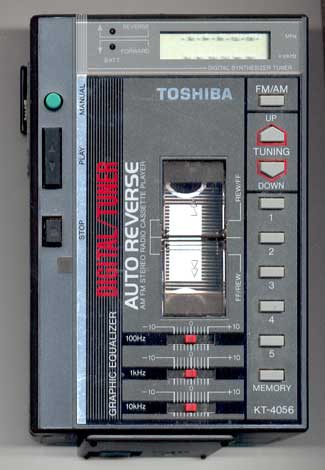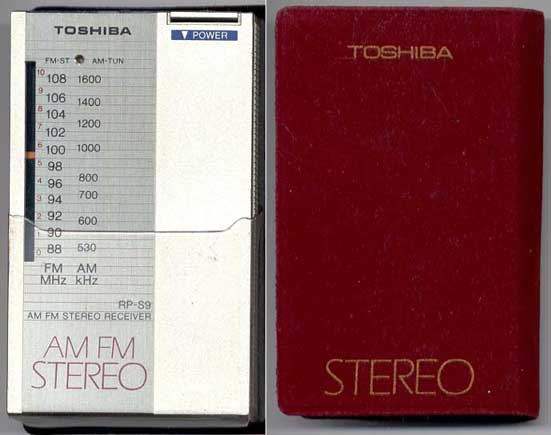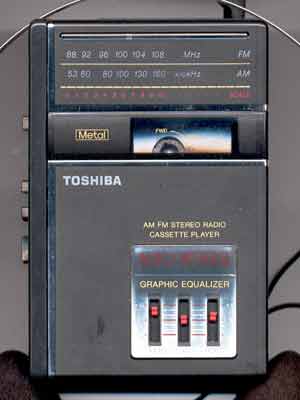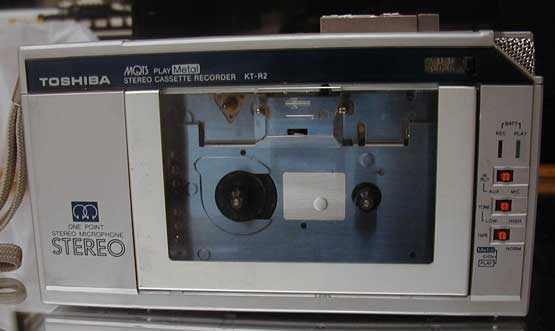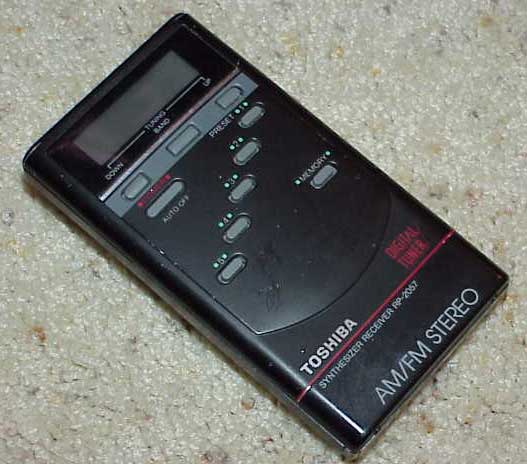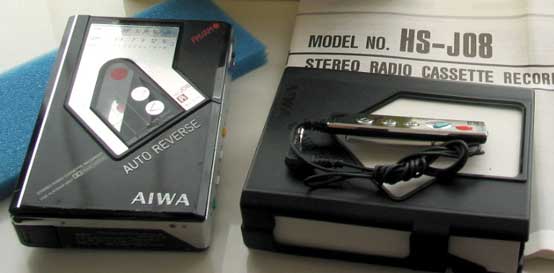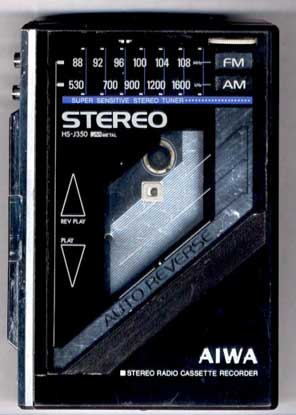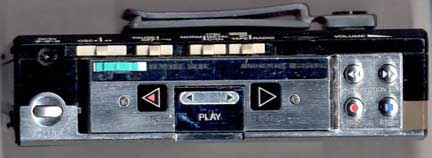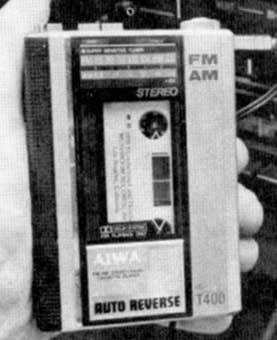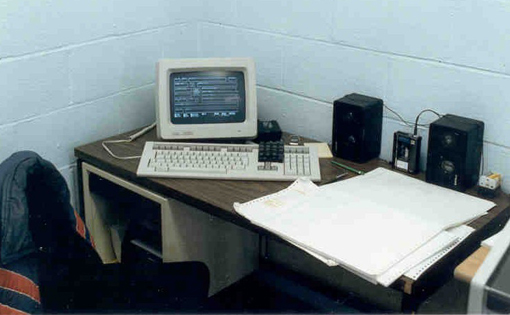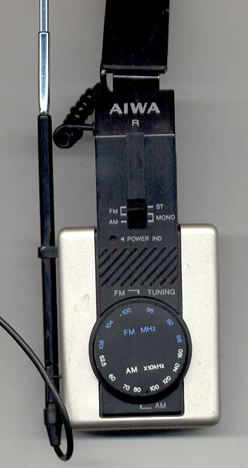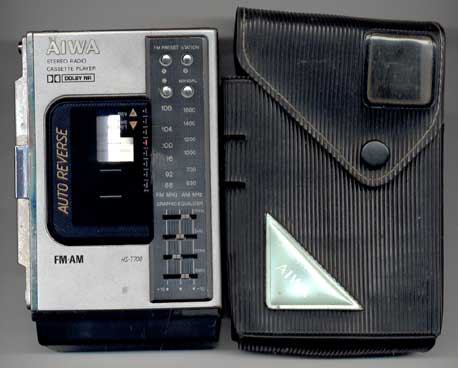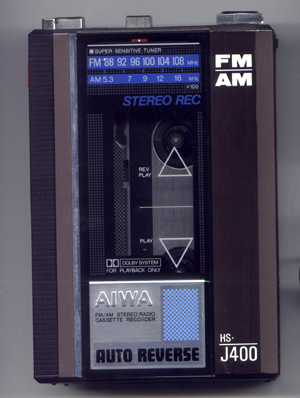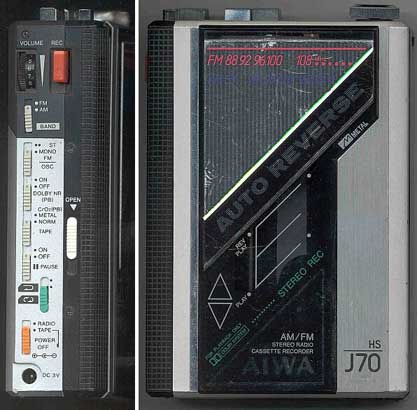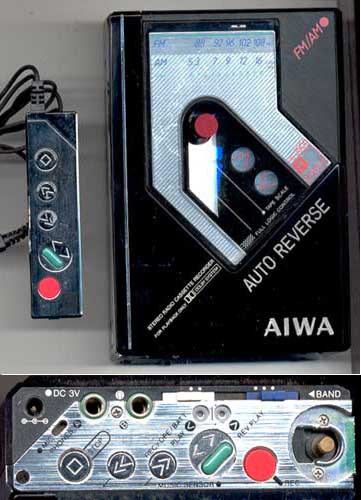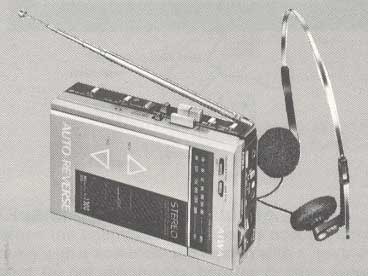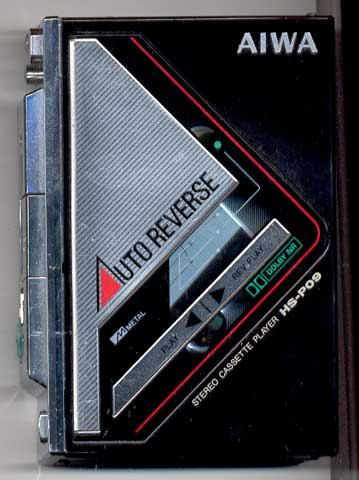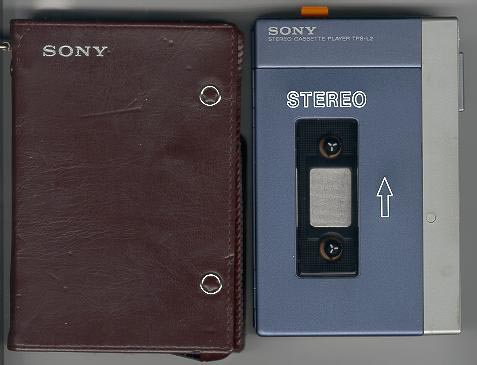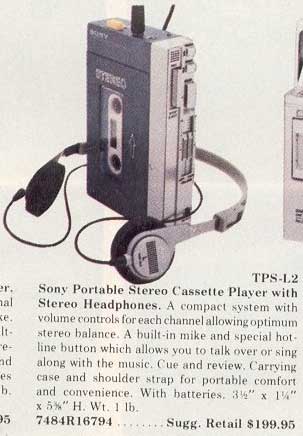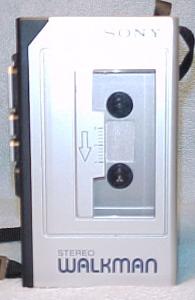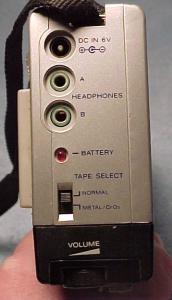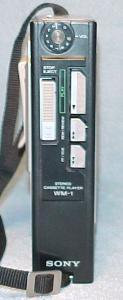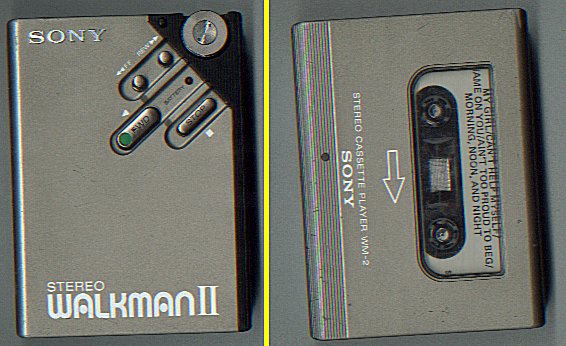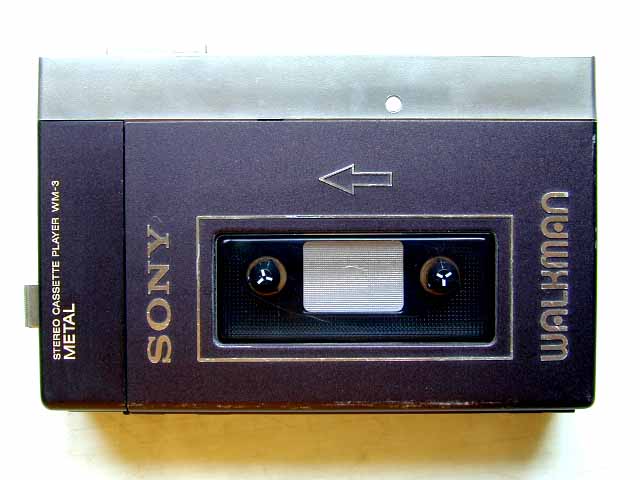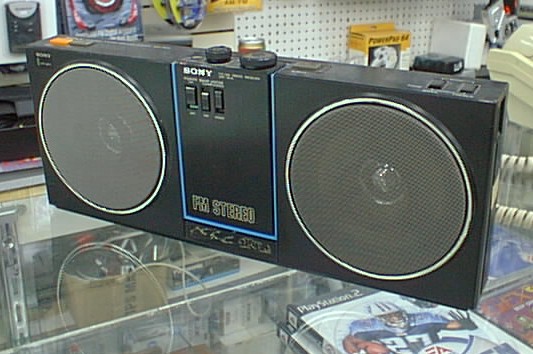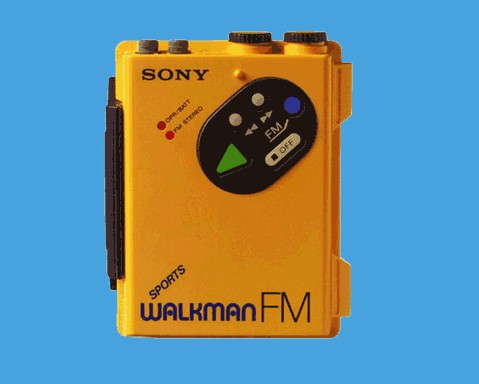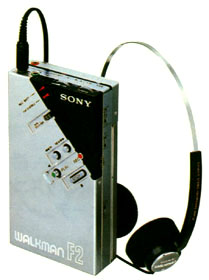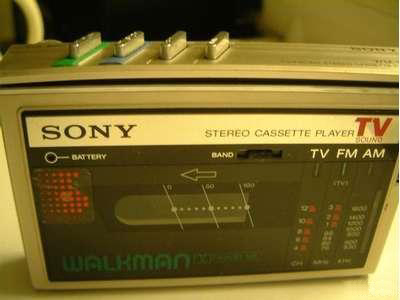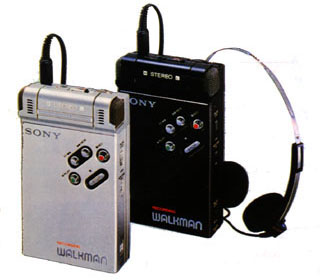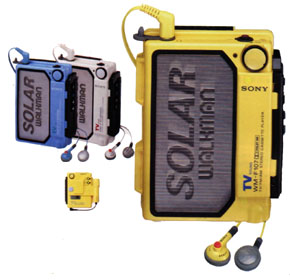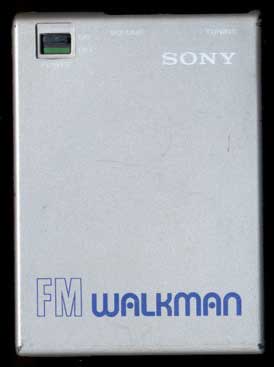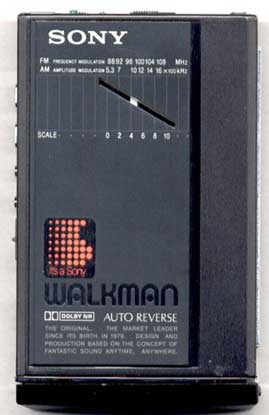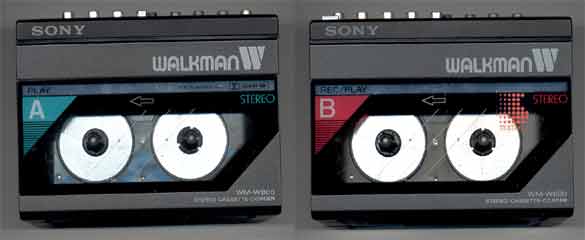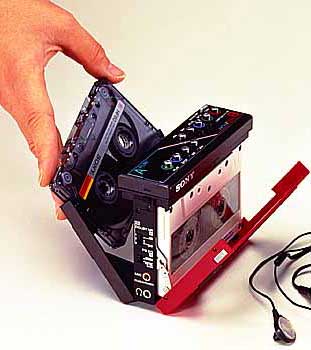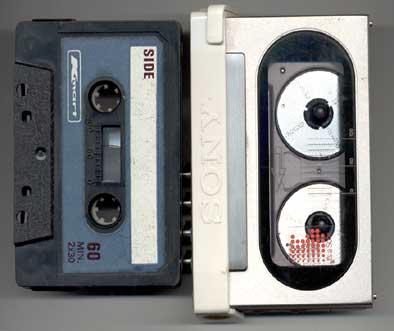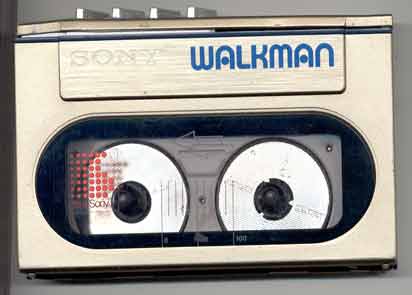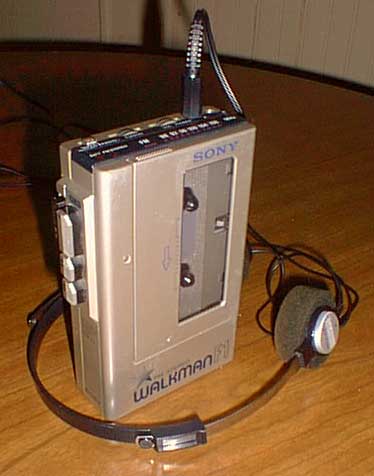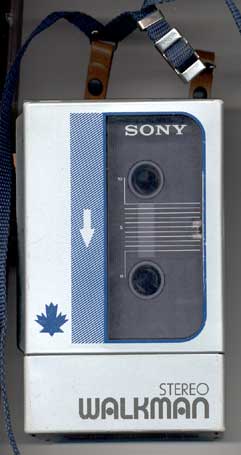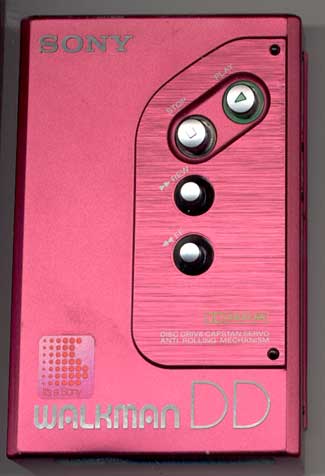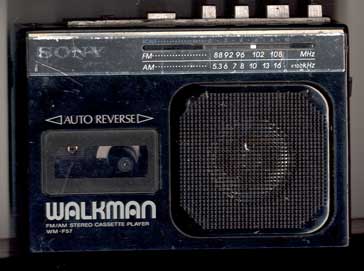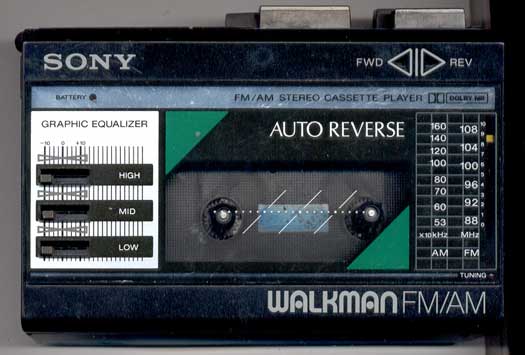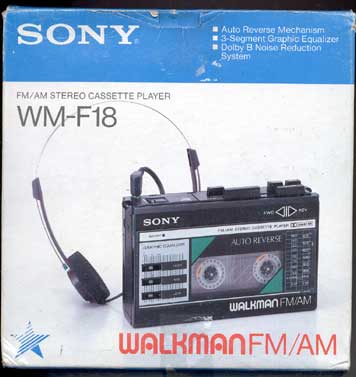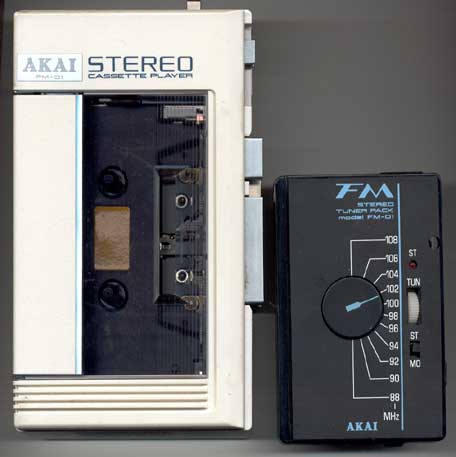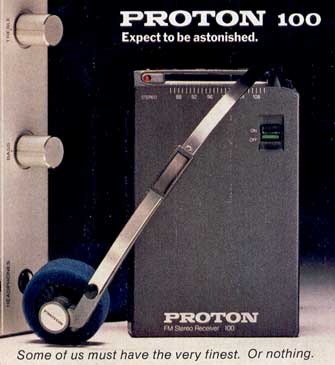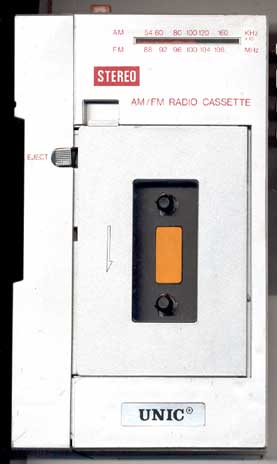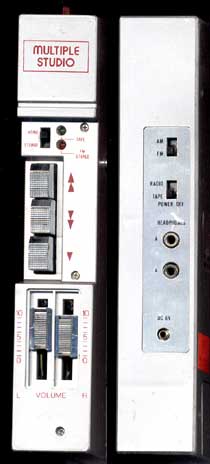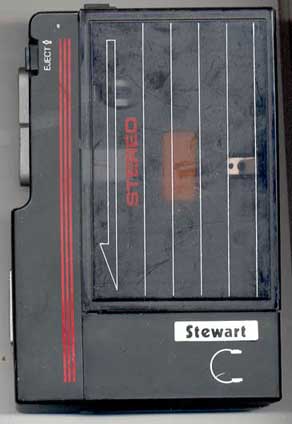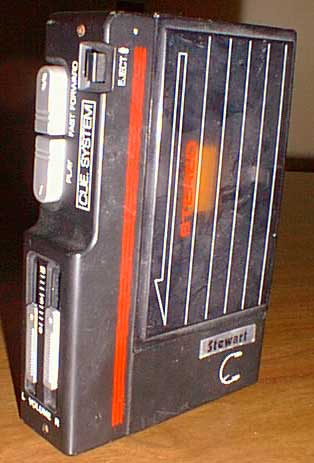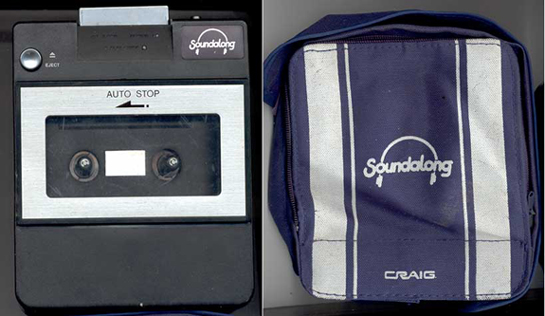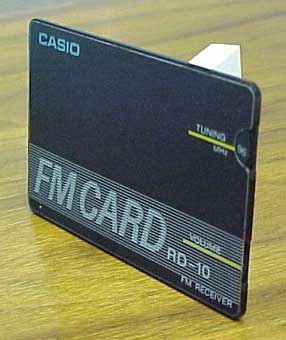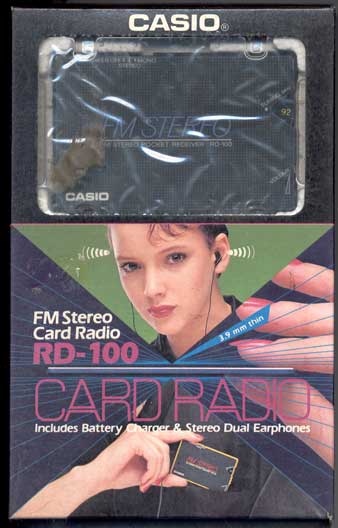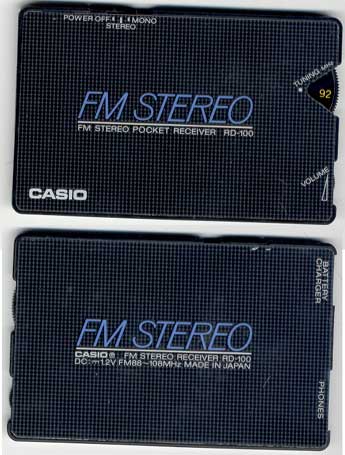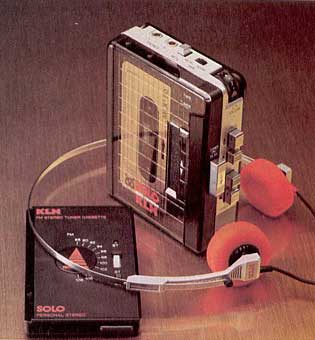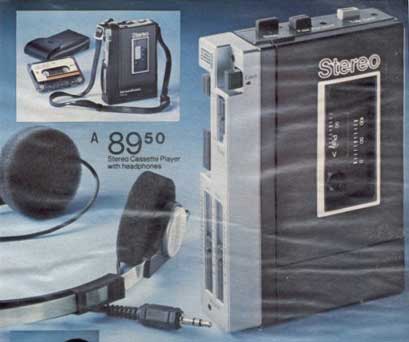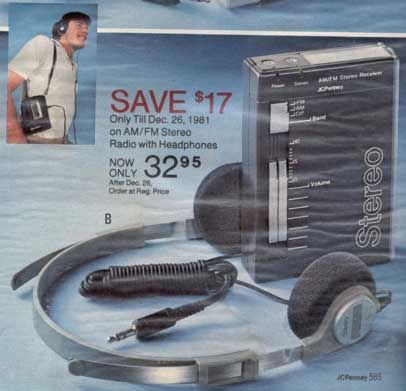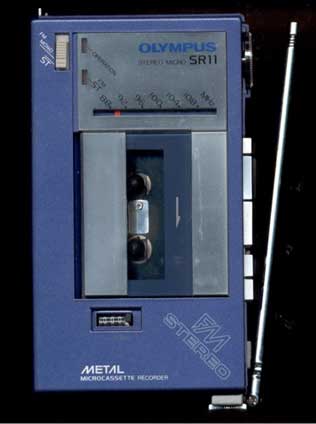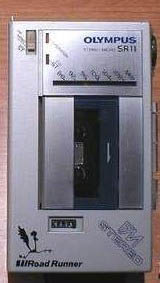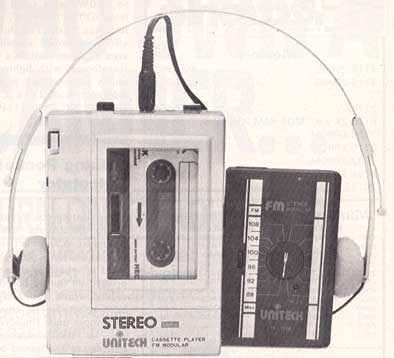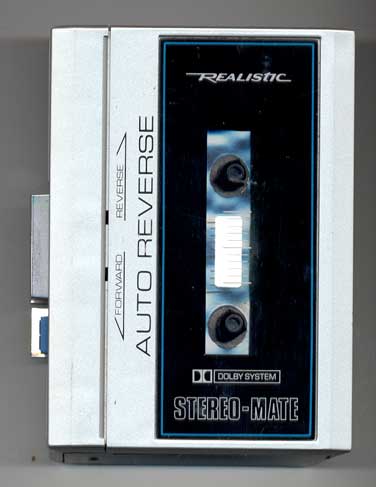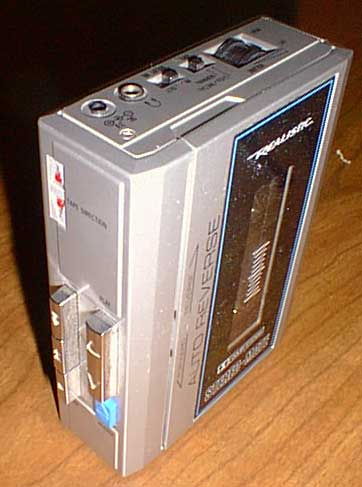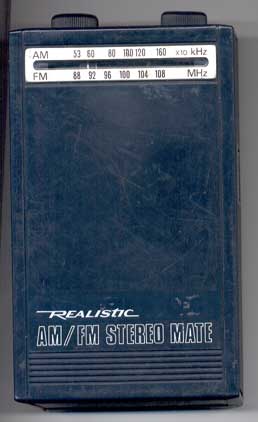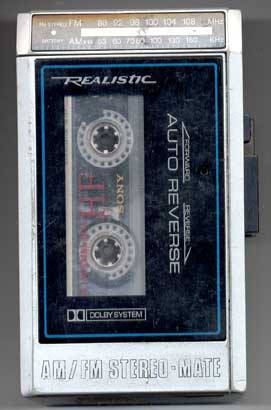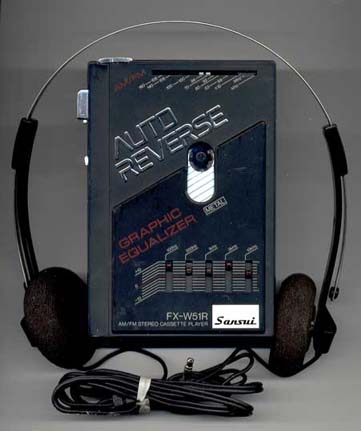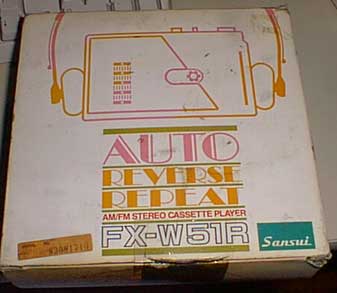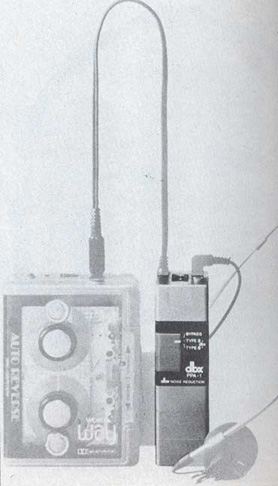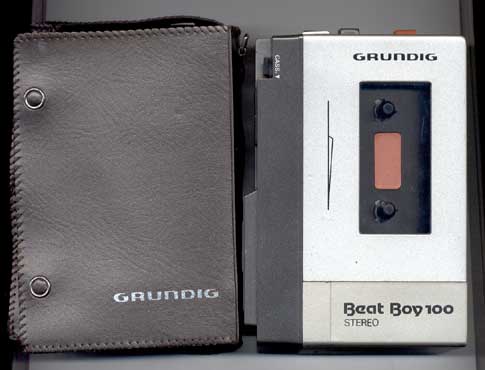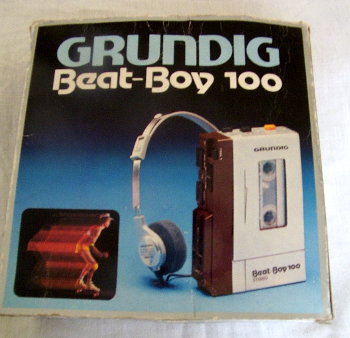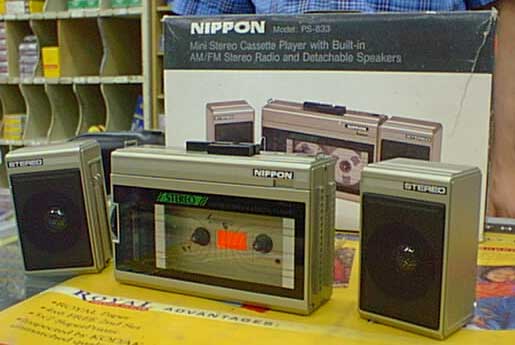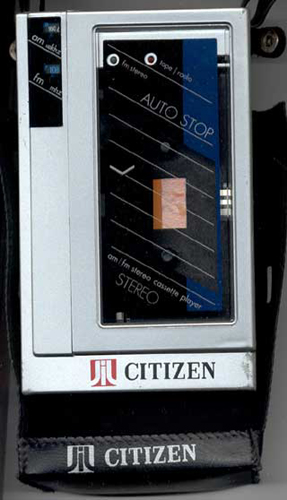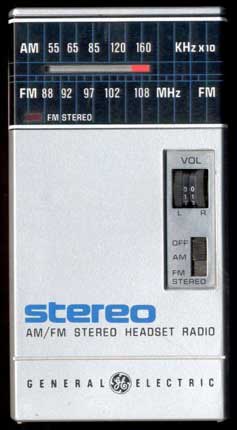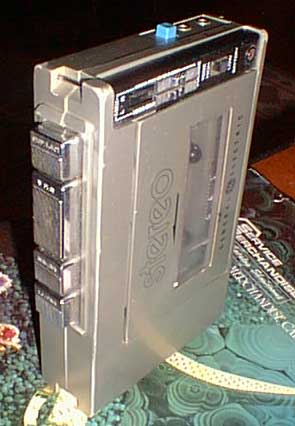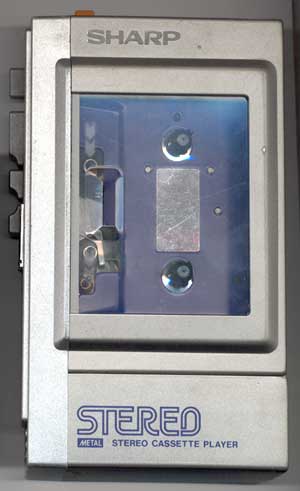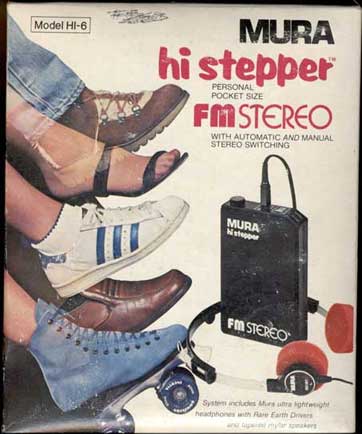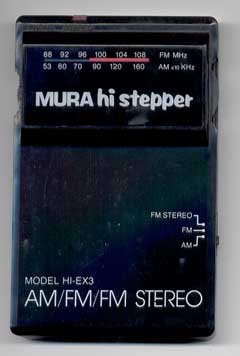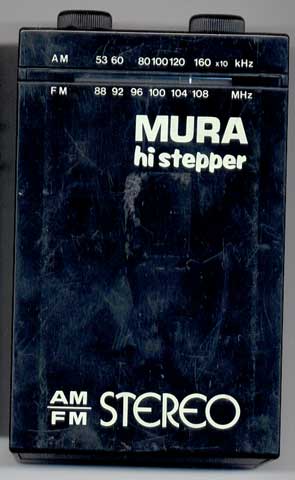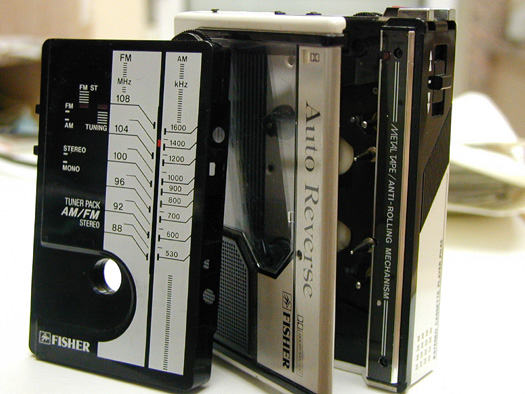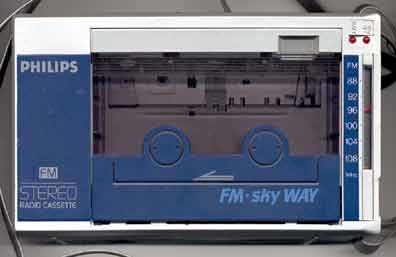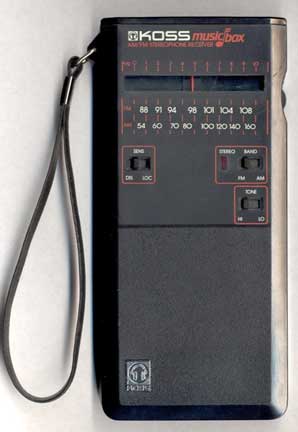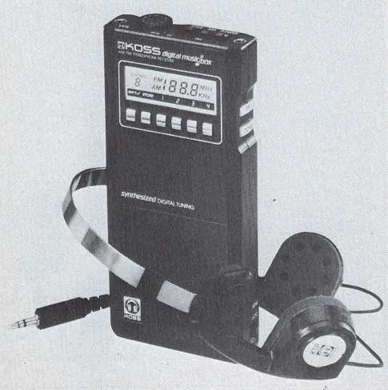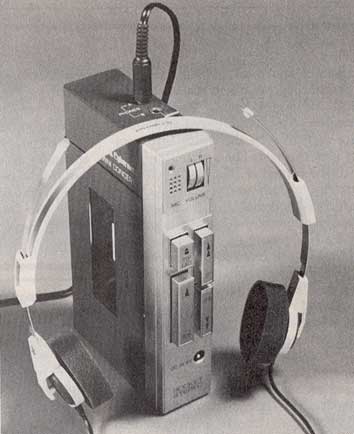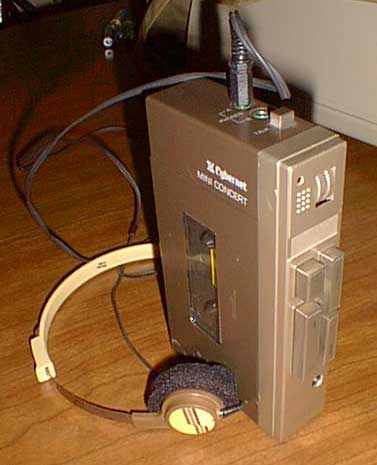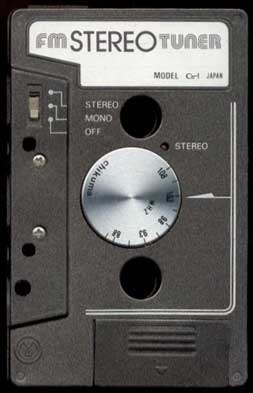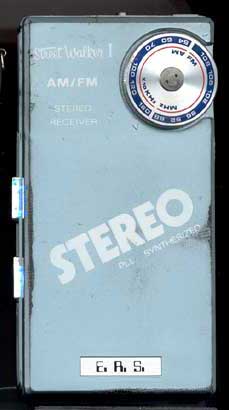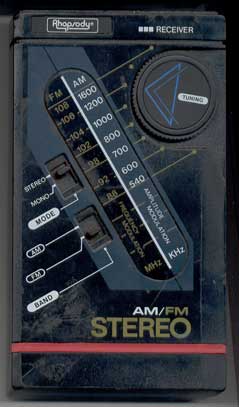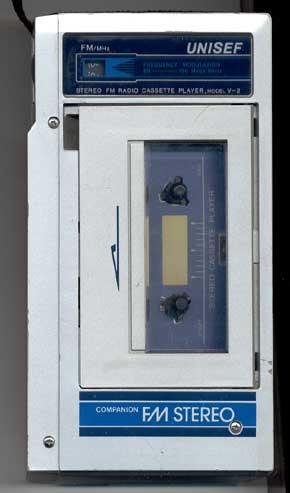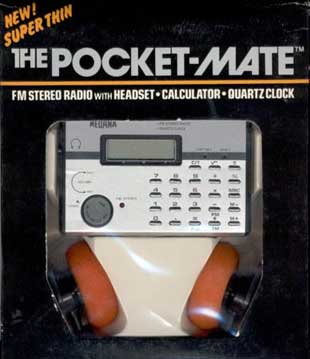Category Archives: Walkman
1989 Panasonic Releases
The Vintage Walkman Database
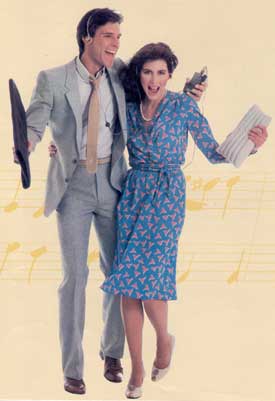 This was an effort to capture data from personal stereo cassette and radio devices into one list. It’s a massive undertaking given the number of models sold during the heyday of this technology. First captured in 2003, no other list existed on the Internet so we spent many weekends in the local library scanning dozens of audio and pop culture magazines for advertisements. Please use this as a guide or checklist in your effort to uncover those old, forgotten personal stereos. We are looking for a way to present in this a Wiki-like format so the world can offer their input.
This was an effort to capture data from personal stereo cassette and radio devices into one list. It’s a massive undertaking given the number of models sold during the heyday of this technology. First captured in 2003, no other list existed on the Internet so we spent many weekends in the local library scanning dozens of audio and pop culture magazines for advertisements. Please use this as a guide or checklist in your effort to uncover those old, forgotten personal stereos. We are looking for a way to present in this a Wiki-like format so the world can offer their input.
| Brand | Model | Year | US Price | function | radio band(s) | notes (a/r=auto reverse; l-r=left&right) | ||
| Aiwa | TPS-30 | 1980 | $160 | recorder | n/a | first personal stereo cassette recorder | ||
| Aiwa | CS-J1 | 1981 | $200 | recorder | ||||
| Aiwa | CS-J1SY | 1982 | $240 | recorder | FM/FM Stereo | |||
| Aiwa | HR-S01 | 1982 | $47 | |||||
| Aiwa | HS-J02 | 1982 | $159 | player | FM Stereo | |||
| Aiwa | HS-P02 | 1982 | player | a/r | ||||
| Aiwa | HS-P01 | 1982 | $100 | |||||
| Aiwa | CS-300 | 1983 | $100 | |||||
| Aiwa | HS-F1 | 1983 | $83 | recorder | ||||
| Aiwa | HS-J300 | 1983 | $120 | player | AM/FM Stereo | a/r; telescopic antenna | ||
| Aiwa | HS-J400 | 1983 | $135 | recorder | AM/FM Stereo | a/r | ||
| Aiwa | HS-T400 | 1983 | $115 | player | AM/FM Stereo | a/r | ||
| Aiwa | HS-T02 | 1983 | $100 | player | AM/FM Stereo | |||
| Aiwa | CR-02 | 1984 | $53 | radio | AM/FM/FM Stereo | 1/2″ thick | ||
| Aiwa | HS-F07 | 1984 | $120 | recorder | AM/FM/FM Stereo | a/r | ||
| Aiwa | HS-J110 | 1984 | $140 | recorder | AM/FM Stereo | |||
| Aiwa | HS-J11 | 1984 | $160 | recorder | ||||
| Aiwa | HS-P01MKII | 1984 | $60 | player | ||||
| Aiwa | HS-P02MKII | 1984 | $90 | player | a/r; Dolby B NR | |||
| Aiwa | HS-P05 | 1984 | $60 | player | ||||
| Aiwa | HS-P06 | 1984 | $95 | player | FM Stereo | |||
| Aiwa | HS-P06MKII | 1984 | $90 | |||||
| Aiwa | SC-A3 | 1984 | $40 | |||||
| Aiwa | SC-A5 | 1984 | $60 | |||||
| Aiwa | CR-03 | 1985 | $40 | |||||
| Aiwa | CR-05 | 1985 | $45 | |||||
| Aiwa | HS-J07 | 1985 | $120 | recorder | ||||
| Aiwa | HS-J500 | 1985 | $140 | player | AM/FM Stereo | Dolby B NR; a/r; anti-rolling; twin headphone jacks |
||
| Aiwa | HS-P05MKII | 1985 | $45 | player | ||||
| Aiwa | HS-S02 | 1985 | $50 | |||||
| Aiwa | HS-J08 | 1985 | $90 | recorder | FM Stereo | a/r; Dolby B NR; wired remote | ||
| Aiwa | SCA-5 | 1985 | $45 | |||||
| Aiwa | HS-P07 | 1985 | $90 | player | ||||
| Aiwa | HS-T200 | 1986 | $90 | |||||
| Aiwa | HS-G500 | 1986 | $110 | player | Dolby B NR; twin headphone jacks; a/r; eq; wired remote control | |||
| Aiwa | HS-J600 | 1986 | $165 | |||||
| Aiwa | HS-T500 | 1986 | $140 | player | ||||
| Aiwa | HS-G600 | 1987 | $104 | player | ||||
| Aiwa | HS-J350 | 1987 | $125 | recorder | AM/FM Stereo | a/r; | ||
| Aiwa | HS-J600A | 1987 | $165 | player | ||||
| Aiwa | HS-T200 | 1987 | $80 | |||||
| Aiwa | HS-T260 | 1987 | $50 | player | AM/FM Stereo | Dolby B NR | ||
| Aiwa | HS-T600 | 1987 | $140 | player | AM/FM Stereo | |||
| Aiwa | HS-J800 | 1988 | $240 | recorder | AM/FM/TV | digital; clock; Dolby B NR; a/r | ||
| Aiwa | HS-G700 | 1988 | $110 | |||||
| Aiwa | HS-J360 | 1988 | $100 | |||||
| Aiwa | HS-J700 | 1988 | $170 | |||||
| Aiwa | HS-T260 | 1988 | $65 | player | AM/FM Stereo | Dolby B NR | ||
| Aiwa | HS-T280 | 1988 | $85 | player | FM Stereo | digital | ||
| Aiwa | HS-T380 | 1988 | $110 | player | AM/FM Stereo | digital | ||
| Aiwa | HS-T600 | 1988 | $150 | |||||
| Aiwa | HS-T700 | 1988 | $160 | |||||
| Aiwa | HS-T800 | 1988 | $170 | |||||
| Aiwa | HS-J900 | 1989 | $190 | recorder | ||||
| Aiwa | HS-S900 | 1989 | $200 | |||||
| Aiwa | HS-T100 | 1989 | player | AM/FM Stereo | ||||
| Aiwa | HS-T210 | 1989 | player | a/r | ||||
| Aiwa | HS-T220 | 1989 | player | a/r,eq | ||||
| Aiwa | HS-T370 | 1989 | player | compact | ||||
| Akai | PM-01 | 1981 | $170 | player | FM/FM Stereo | tuner module | ||
| Caprice | 1981 | player | ||||||
| Casio | RD-10 | 1985 | radio | FM Stereo | credit card size | |||
| Casio | RD-100 | 1986 | radio | FM/FM Stereo | credit card size | |||
| Craig | J700 | 1981 | $99 | player | “Soundalong”; twin headphone jacks; hi-lo tone switch; hotline mic; l-r volume | |||
| Cybernet | Mini Concert PS-101 | 1981 | $70 | player | twin headphone jacks; l-r volume controls | |||
| Cybernet | Mini Concert PS-103 | 1982 | $130 | player | FM/FM Stereo | tuner module | ||
| DAK | Micro XV5000 | 1983 | $80 | player | a/r; (re-packaged for DAK by ??) | |||
| Emerson | 1981 | player | ||||||
| GE | 7-1000 | 1981 | radio | AM/FM/FM Stereo | “Stereo Radio Escape”; l-r volume slide controls | |||
| GE | 3-5270 | 1981 | player | “Stereo Tape Escape”; two HP jacks; hi-lo tone switch; mute; left-right volume | ||||
| GE | 3-5271 | 1981 | player | FM Stereo | “Stereo Great Escape”; two HP jacks; hi-lo tone switch; mute; left-right volume | |||
| GE | 3-5273 | 1983 | $50 | player | AM/FM Stereo | “Stereo Great Escape”; Stereo indicator LED | ||
| GE | 7-1600 | 1983 | $20 | player | AM/FM Stereo | Stereo indicator LED | ||
| GE | 3-5432 | 1985 | player | AM/FM Stereo | eq | |||
| GE | 3-5435 | 1986 | player | eq | ||||
| GE | 7-1285 | 1986 | radio | |||||
| GE | 7-1990 | 1989 | $25 | player | AM/FM Stereo | splashproof | ||
| Goldstar | TSM-22 | 1982 | player | l-r volume control | ||||
| Grundig | Beat-Boy 100 | 1981 | player | |||||
| Guardian | 1981 | player | ||||||
| Gustronic | 1981 | player | ||||||
| Hator Seiko | Mr. FM | 1984 | radio | FM | two position volume switch; micro earbud shape; button battery cell | |||
| Hip Pocket | FM Cassette | 1982 | $70 | |||||
| Hitachi | Walkalong | 1989 | $60 | recorder | AM/FM Stereo | |||
| Infinity | 1981 | player | FM/FM Stereo | tuner module; Dolby stereo | ||||
| JC Penney | SurroundSound | 1981 | $90 | player | l-r volume controls; hotline mic | |||
| JC Penney | Stereo | 1981 | $33 | radio | AM/FM Stereo | l-r volume control | ||
| JIL – Candle – Citizen – Walkymusic | 1984 | $70 | recorder | AM/FM Stereo | telescopic antenna; built-in speakers; auto-stop; dual condenser mikes; Canada dist. | |||
| JIL – Candle – Citizen – Walkymusic | 1984 | $70 | player | AM/FM Stereo | telescopic antenna; built-in speakers; auto-stop; a/r; Canada dist. | |||
| JIL – Candle – Citizen – Walkymusic | 1984 | $40 | player | AM/FM Stereo | l-r volume slide controls; dual headphone jacks; built-in speaker; auto-stop; Canada dist. | |||
| JIL – Candle – Citizen – Walkymusic | 1984 | $50 | player | AM/FM Stereo | breakaway speakers; auto-stop; Canada dist. | |||
| JIL – Candle – Citizen – Walkymusic | 1984 | $50 | player | AM/FM Stereo | breakaway speakers; auto-stop; Canada dist. | |||
| JIL – Candle – Citizen – Walkymusic | 1984 | $30 | player | AM/FM Stereo | auto-stop; Canada dist. | |||
| JIL – Candle – Citizen – Walkymusic | 1984 | $40 | player | a/r; Canada dist. | ||||
| JIL – Candle – Citizen – Walkymusic | 1984 | $25 | player | extra-small; Canada dist. | ||||
| JIL – Candle – Citizen – Walkymusic | 1984 | $20 | player | twin headphone jacks; Canada dist. | ||||
| JIL – Candle – Citizen – Walkymusic | 1984 | $15 | player | Canada dist. | ||||
| JIL – Candle – Citizen – Walkymusic | 1984 | $15 | radio | AM/FM Stereo | built-in speaker; telescopic antenna; stereo indicator LED; Canada dist. | |||
| JIL – Candle – Citizen – Walkymusic | 1984 | $12 | radio | AM/FM/FM Stereo | slimline; l-r volume control; stereo indicator LED; Canada dist. | |||
| Juliette | 1984 | $14 | radio | AM/FM/FM Stereo | “Walk-About”; stereo indicator LED | |||
| JVC | CQ-1 | 1983 | $70 | player | Dolby NR | |||
| JVC | CQ-1 | 1983 | $80 | player | ||||
| JVC | CQ-11K | 1983 | $120 | player | a/r; Dolby B NR | |||
| JVC | CQ-F2 | 1983 | $159 | player | FM Stereo | radio cassette module; Dolby B NR | ||
| JVC | CQ-F22K | 1983 | $190 | player | AM/FM/FM Stereo | a/r; Dolby B NR; anti-rolling; hi-lo switch; detachable radio |
||
| JVC | CQ-11KJW | 1984 | $80 | player | a/r; Dolby B NR; tone control | |||
| JVC | CQ-R10JW | 1985 | $35 | radio | AM/FM Stereo | headset radio; detachable tuner pack and battery pack | ||
| JVC | CX-7BK | 1989 | $60 | player | dolby,a/r | |||
| JVC | CX-F30 | 1989 | $70 | player | AM/FM Stereo | a/r | ||
| Kasuga | Recorder/Player | 1983 | $90 | recorder | FM/FM Stereo | two headphone jacks; l-r balance; hi-lo tone; internal stereo microphone |
||
| Kenwood | CP10 | 1983 | $80 | player | ||||
| Kenwood | CP-80 | 1983 | $190 | player | AM/FM/FM Stereo | a/r; tuner module; snap-on micro speakers; Dolby B NR | ||
| KLH | Solo | 1981 | $170 | player | FM/FM Stereo | radio cassette module; Dolby B NR | ||
| KLH | Solo II | 1983 | $150 | player | FM/FM Stereo | radio cassette module; a/r; two headphone jacks; l-r volume |
||
| Koss | Music Box | 1981 | $64 | radio | AM/FM/FM Stereo | hi-lo tone switch | ||
| Koss | Music Box Cassette Player | 1983 | $110 | player | Dolby NR | |||
| Koss | Music Digital Music Box | 1983 | $110 | radio | AM/FM/FM Stereo | digital; 8 presets; signal strength & battery strength readout; safeLite sound level indicator |
||
| Koss | KMBAZ | 1984 | $42 | radio | AM/FM/FM Stereo | digital | ||
| Koss | A3 | 1985 | $70 | player | AM/FM/FM Stereo | folding headphones | ||
| Liberty | 1981 | player | ||||||
| Maxam | RS-881 | 1983 | $15 | radio | FM/FM Stereo | “The Scooter” | ||
| Medana | Pocket-Mate | 198? | radio | FM Stereo | LCD calculator; LCD clock | |||
| MGT | XT-3000 | 1983 | $7 | radio | FM Stereo | offered thru DAK w/ purchase of 10 cassettes | ||
| Mona | 1981 | player | ||||||
| Mura | Hi-Stepper HI-3 | 1981 | $80 | radio | AM/FM/FM Stereo | incl. Red Set III Headphones; carrying case | ||
| Mura | Hi-6 | 1981 | radio | FM Stereo | ||||
| Mura | HI-EX | 1982 | radio | FM/FM Stereo | slim design; hi-lo tone switch; stereo LED | |||
| Mura | Sun Stepper | 1986 | $40 | radio | AM/FM Stereo | solar powered; battery-free | ||
| NeWave | 0817 | 1982 | $39 | radio | AM/FM Stereo | twin headphone jack; LED indicator; l-r volume control | ||
| Nippon | FS-884 | 1982 | player | FM Stereo | twin headphone jack; hotline mic; LED indicator; l-r volume control | |||
| Olympus | SR-11 | 1982 | $200 | micro-recorder | AM/FM/FM Stereo | micro-cassette format; external antenna | ||
| Panasonic | RQ-J33 | 1981 | player | |||||
| Panasonic | RF-10 | 1982 | $77 | radio | AM/FM/FM Stereo | hi-lo tone switch; vinyl case | ||
| Panasonic | RX-2700 | 1982 | $250 | recorder | AM/FM Stereo | auto-stop; telescopic antenna; internal speaker; strap and case | ||
| Panasonic | RQ-J20X | 1982 | player | dbx NR; “dbx Way”; wow & flutter 0.035 | ||||
| Panasonic | RQ-J5 | 1982 | $100 | casette player | ||||
| Panasonic | RQ-J6 | 1982 | $119 | recorder | built-in stereo mike; one-touch recording | |||
| Panasonic | RX-1950 | 1982 | $175 | |||||
| Panasonic | RQ-J55 | 1982 | $110 | recorder | ||||
| Panasonic | RQ-WJ1 | 1983 | player | mini-size | ||||
| Panasonic | RQ-J2 | 1983 | $55 | player | mini-size | |||
| Panasonic | RF-444 | 1983 | $24 | radio | AM/FM Stereo | hi-lo tone control; FM stereo indicator LED | ||
| Panasonic | RQ-J36 | 1983 | $70 | recorder | pause; tape counter; auto-stop; built-in mike | |||
| Panasonic | RF-8 | 1983 | $60 | radio | AM/FM Stereo | ultra-compact; stereo/battery strength | ||
| Panasonic | RQ-AR1 | 1984 | $60 | player | a/r | |||
| Panasonic | RX-S35 | 1984 | $75 | player | AM/FM Stereo | ultra-mini; a/r; Dolby B NR | ||
| Panasonic | RQ-J50 | 1985 | $20 | player | clear plastic well door | |||
| Panasonic | RQ-J60 | 1985 | $20 | player | compact design | |||
| Panasonic | RQ-J16 | 1985 | $30 | player | a/r | |||
| Panasonic | RQ-J7 | 1985 | $25 | player | a/r | |||
| Panasonic | RQ-JA5 | 1985 | $75 | player | eq; a/r; Dolby B NR | |||
| Panasonic | RX-1925 | 1985 | $35 | player | AM/FM Stereo | LED battery indicator | ||
| Panasonic | RX-1930 | 1985 | $45 | player | AM/FM Stereo | eq; FM/battery LED indicator | ||
| Panasonic | RX-S25A | 1985 | $50 | player | AM/FM Stereo | a/r | ||
| Panasonic | RX-S28 | 1985 | $70 | recorder | AM/FM Stereo | a/r; | ||
| Panasonic | RX-S38 | 1985 | $100 | recorder | AM/FM Stereo | a/r; separate amplified speakers; pause; built-in mike | ||
| Panasonic | RX-SA10 | 1985 | $110 | player | AM/FM Stereo | a/r; Dolby B NR; ultra-compact; carrying case | ||
| Panasonic | RF-110 | 1985 | radio | FM Stereo | eq | |||
| Panasonic | RF-11 | 1985 | 30 | radio | AM/FM/FM Steroe | eq | ||
| Panasonic | RF-H25 | 1985 | $100 | radio | AM/FM Stereo | “Sound Card”; “world’s thinnest & lightest stereo radio”; ni-cad battery | ||
| Panasonic | RF-H5 | 1985 | $45 | radio | FM/FM Stereo | “Sound Band”; aux-in jack | ||
| Panasonic | RF-H20 | 1985 | $30 | radio | FM/FM Stereo | RHC microchip; Ultra-Phonic mode switch; black or red | ||
| Panasonic | RF-H5A | 1986 | $63 | radio | FM Stereo | |||
| Panasonic | RQ-JA61 | 1986 | $20 | casette player | ||||
| Panasonic | RX-CW43 | 1986 | $120 | player/recorder | AM/FM Stereo | double cassette | ||
| Panasonic | RSX-35 | 1986 | $75 | player | AM/FM Stereo | Dolby NR | ||
| Panasonic | RX-1924 | 1986 | $30 | player | AM/FM Stereo | |||
| Panasonic | RX-HD10 | 1986 | $200 | player & recorder | AM/FM Stereo | radio cassette module; double cassette | ||
| Panasonic | RX-SA70 | 1986 | $50 | player | a/r | |||
| Panasonic | RX-SA77 | 1986 | $70 | player | AM/FM Stereo | Dolby NR; eq | ||
| Panasonic | RX-SA25 | 1987 | $60 | player | AM/FM Stereo | |||
| Panasonic | RX-SA78 | 1987 | $80 | player | AM/FM Stereo | Dolby NR; a/r; eq; 1 FM preset | ||
| Panasonic | RX-SR35 | 1987 | $80 | player | AM/FM Stereo | |||
| Panasonic | RX-FM14 | 1987 | $50 | player | AM/FM Stereo | 4 colors | ||
| Panasonic | RX-SA66 | 1987 | $50 | player | AM/FM Stereo | a/r | ||
| Panasonic | RX-FM27 | 1987 | $60 | player | AM/FM Stereo | eq | ||
| Panasonic | RX-SA255 | 1988 | $200 | player | AM/FM Stereo | ultra-small | ||
| Panasonic | RX-SR25 | 1988 | $60 | recorder | AM/FM Stereo | |||
| Panasonic | RX-SA60 | 1988 | $33 | player | AM/FM Stereo | |||
| Panasonic | RX-SA79 | 1988 | $130 | player | AM/FM Stereo | Dolby,XBS bass system,eq,a/r,nicad battery | ||
| Panasonic | RX-SA80 | 1988 | $100 | player | AM/FM Stereo | a/r | ||
| Panasonic | RQ-V150 | 1989 | $50 | player | AM/FM Stereo | a/r,eq | ||
| Panasonic | RQ-V340 | 1989 | $130 | player | AM/FM Stereo | xbs,a/r,dolby | ||
| Panasonic | RQ-V340 | 1989 | $130 | player | AM/FM Stereo | xbs,dolby,a/r | ||
| Panasonic | RQ-V50 | 1989 | $30 | player | AM/FM Stereo | dx switch | ||
| Panasonic | RQJ-A52 | 1989 | $20 | player | ||||
| Panasonic | RX-SR39 | 1989 | $80 | recorder | AM/FM Stereo | |||
| Panasonic | RX-SA64 | 1989 | $30 | player | AM/FM Stereo | |||
| Philips | D6628 | 1983 | player | FM Stereo | “Skyway” | |||
| Pioneer | PK-3 | 1984 | $100 | |||||
| Pioneer | PK-35V | 1984 | $90 | |||||
| Pioneer | PK-5AW | 1984 | $110 | player | all-weather; a/r | |||
| Pioneer | PK-9SV | 1984 | $130 | |||||
| Pioneer | PK-F9 | 1984 | $140 | |||||
| Pioneer | PK-R7AW | 1984 | $120 | |||||
| Proton | 100 | 1982 | $120 | radio | FM Stereo | Schotz circuitry; bass & treble controls | ||
| Randix Audiologic | Soundaround | 1981 | player | |||||
| RCD | 1983 | $23 | radio | FM Stereo | earbud headphones | |||
| RCD | 1983 | $28 | radio | AM/FM Stereo | earbud headphones | |||
| Sanyo | M-5550 | 1981 | player | aka Sportster; mic; AMSS; pitch control | ||||
| Sanyo | M-4430 | 1981 | player | aka Sportster; mic; AMSS | ||||
| Sanyo | C-7 | 1982 | $239 | |||||
| Sanyo | MG-10 | 1982 | $46 | |||||
| Sanyo | MG-1 | 1982 | $70 | |||||
| Sanyo | MG-2 | 1982 | $80 | player | AM/FM/FM Stereo | |||
| Sanyo | MG-30 | 1982 | $64 | player | AM/FM/FM Stereo | |||
| Sanyo | MG-9 | 1982 | $35 | player | ||||
| Sanyo | MG-100 | 1983 | $100 | |||||
| Sanyo | MG-110DT | 1983 | $110 | |||||
| Sanyo | MG-12 | 1983 | $35 | |||||
| Sanyo | MG-15 | 1983 | $43 | |||||
| Sanyo | MG-16D | 1983 | $65 | player | dolby NR | |||
| Sanyo | MG-31 | 1983 | $50 | player | AM/FM/FM Stereo | |||
| Sanyo | MG-34DT | 1983 | $90 | player | AM/FM/FM Stereo | tuner module; Dolby; “Sportster” | ||
| Sanyo | MG-35 | 1983 | $56 | |||||
| Sanyo | MG-36D | 1983 | $80 | |||||
| Sanyo | MG-7 | 1983 | $25 | player | l-r volume control; auto-stop | |||
| Sanyo | MG-8 | 1983 | $30 | |||||
| Sanyo | MG-31A | 1984 | $50 | |||||
| Sanyo | MG-32 | 1984 | $60 | |||||
| Sanyo | MG-41 | 1984 | $50 | player | AM/FM/FM Stereo | |||
| Sanyo | MG-55 | 1984 | $45 | |||||
| Sanyo | MG-80 | 1984 | $70 | |||||
| Sanyo | MG-80D | 1984 | $55 | player | FM Stereo | a/r | ||
| Sanyo | MG-95 | 1984 | $55 | player | AM/FM/FM Stereo | a/r | ||
| Sanyo | MG-98D | 1984 | $70 | |||||
| Sanyo | RP-45 | 1984 | $25 | radio | AM/FM Stereo | hi-lo tone control | ||
| Sanyo | MG-15A | 1985 | $30 | player | ||||
| Sanyo | MGP-10 | 1985 | $15 | player | auto-stop | |||
| Sanyo | MGP-16 | 1985 | $23 | player | auto-stop; anti-rolling; tone control; battery LED | |||
| Sanyo | MGP-26 | 1985 | $30 | player | a/r; auto-stop; anti-rolling; tone control; battery LED | |||
| Sanyo | MGP-30 | 1985 | $35 | player | eq; a/r | |||
| Sanyo | MGP-44 | 1985 | $80 | player | eq; a/r; anti-rolling; Dolby B NR | |||
| Sanyo | MGR-60 | 1985 | $30 | player | AM/FM Stereo | auto-stop | ||
| Sanyo | MGR-66 | 1985 | $33 | player | AM/FM/FM Stereo | like MGR-66 with rewind | ||
| Sanyo | MGR-70 | 1985 | $40 | player | AM/FM/FM Stereo | eq; anti-rolling; auto-stop | ||
| Sanyo | MGR-76 | 1985 | $48 | player | AM/FM/FM Stereo | mini-size; a/r; anti-rolling; auto-stop | ||
| Sanyo | MGR-80 | 1985 | $55 | player | AM/FM Stereo | a/r; anti-rolling; mute | ||
| Sanyo | MGR-99 | 1985 | $100 | player | AM/FM Stereo | ultra-slim; Dolby B NR; a/r; anti-rolling | ||
| Sanyo | MGR-150 | 1985 | $120 | recorder | AM/FM Stereo | ultra-slim; Dolby B NR; a/r; anti-rolling; pause | ||
| Sanyo | RP-65 | 1985 | $18 | radio | FM Stereo | hi-lo tone control | ||
| Sanyo | RP-66A | 1985 | $19 | radio | AM/FM Stereo | hi-lo tone control | ||
| Sanyo | RP-67A | 1985 | $40 | radio | AM/FM/FM Stereo | credit card size; hi-lo tone control | ||
| Sanyo | RP-68 | 1985 | $30 | radio | AM/FM Stereo | eq | ||
| Sanyo | RP-70 | 1985 | $35 | radio | AM/FM Stereo | telescopic antenna; hi-lo tone control | ||
| Sanyo | RP-80 | 1985 | $45 | radio | AM/FM/FM Stereo | headset; mute; external antenna jack | ||
| Sharp | JC-11 | 1986 | $65 | |||||
| Sharp | JC-22 | 1986 | $90 | |||||
| Sharp | JC-790 | 1986 | $150 | player | AM/FM Stereo | a/r; fast playback; Dolby | ||
| Samsung | ST-206 | 1982 | player | FM Stereo | “MyMy”;FM cssette module | |||
| Sharp | JC-850 | 1987 | $100 | player | AM/FM Stereo | Dolby NR; eq; a/r | ||
| Sharp | JC-568 | 1989 | $140 | player | AM/FM Stereo | digital,10 presets,eq,a/r,3/89 p 22 | ||
| Sharp | JC-518 | 1989 | $90 | |||||
| Sharp | JCK-15 | 1989 | $60 | player | a/r | |||
| Sony | TPS-L2 | 1979 | $200 | player | intro’d to US in 1980 as Soundabout then marketed as Walkman; two HP jacks; left-right volume; mic “Hot-Line feature; vinyl case |
|||
| Sony | SRF-40W | 1981 | $70 | radio | FM/FM Stereo | two HP jacks | ||
| Sony | SRF-80W | 1981 | $220 | radio | AM/FM/FM Stereo | aka Mystereo; external stereo speaker base | ||
| Sony | WM-1 | 1982 | $100 | player | twin headphone jacks | |||
| Sony | WM-2 | 1981 | $140 | player | ||||
| Sony | WA-33 | 1982 | $130 | |||||
| Sony | WA-55 | 1982 | $156 | player | ||||
| Sony | WM-3 | 1982 | $149 | player | ||||
| Sony | WM-4 | 1982 | $65 | player | ||||
| Sony | WM-5 | 1982 | $100 | player | ||||
| Sony | WM-D6 | 1982 | $250 | recorder | Dolby B NR; LED level indicator; pitch control; quartz-controlled | |||
| Sony | WM-R2 | 1982 | $140 | recorder | built-in stereo mike | |||
| Sony | SRF-33W | 1983 | $55 | radio | FM Stereo | |||
| Sony | SRF-80W | 1983 | $100 | radio | FM Stereo | |||
| Sony | MDR-FM3 | 1983 | $50 | radio | FM Stereo | l-r volume controls; telescopic antenna | ||
| Sony | WM-10 | 1983 | $100 | player | world’s smallest player; Dolby NR; | |||
| Sony | WM-7 | 1983 | $123 | |||||
| Sony | WM-F10 | 1983 | $130 | player | FM Stereo | |||
| Sony | WM-F1 | 1983 | $90 | player | FM Stereo | twin headphone jacks | ||
| Sony | XRM-10 | 1983 | $380 | player | Music Shuttle”; removable cassettte player for car stereo |
|||
| Sony | SRF-5 | 1983 | $55 | radio | FM Stereo | water resistant; dx switch | ||
| Sony | WM-F5 | 1983 | $100 | player | FM Stereo | “Sports”; “Swim Man”; water resistant; soft-touch controls | ||
| Sony | SRF-20W | 1984 | $27 | radio | FM Stereo | local-dx switch; LED tuning indicator | ||
| Sony | WA-66 | 1984 | $130 | |||||
| Sony | WM-16 | 1984 | $70 | player | a/r; Dolby NR | |||
| Sony | WM-8 | 1984 | $45 | player | ||||
| Sony | WM-D6C | 1984 | $250 | recorder | Dolby B+C NR; quartz-lock speed control; disc drive; counter-inertial flywheel; pitch control | |||
| Sony | WM-F10 | 1984 | $110 | |||||
| Sony | WM-F8 | 1984 | $70 | player | FM Stereo | |||
| Sony | WM-R15 | 1984 | $120 | recorder | a/r; Dolby B NR; counter-inertial flywheel; tape counter; pause | |||
| Sony | SRF-201 | 1985 | $70 | radio | FM Stereo | FM Card Walkman; “World’s Smallest Walkman”; 1.2 oz; battery charger; feather-touch volume control |
||
| Sony | SRF-22W | 1985 | $30 | radio | FM Stereo | local-dx switch; LED tuning indicator; twin headphone jacks | ||
| Sony | SRFA-1 | 1985 | $40 | radio | AM Stereo/FM Stereo; local-dx switch; LED tuning indicator | |||
| Sony | WA-200 | 1985 | $130 | |||||
| Sony | WM-10MKII | 1985 | $60 | player | smallest in the world in 1985; counter-inertial flywheel; Dolby B NR | |||
| Sony | WM-10RV | 1985 | $85 | player | a/r; Dolby B NR; counter-inertial flywheel | |||
| Sony | WM-11 | 1985 | $40 | player | ||||
| Sony | WM-11D | 1985 | $35 | player | auto-stop | |||
| Sony | WM-18 | 1985 | $45 | player | same as WM-11D w/ a/r | |||
| Sony | WM-75 | 1985 | $75 | player | “Sports”; a/r; water resistant; Dolby B NR | |||
| Sony | WM-DC2 | 1985 | $160 | player | quartz locking system; disc drive; counter-inertial flywheel; Dolby B+C NR | |||
| Sony | WM-F10MKII | 1985 | $90 | player | AM/FM Stereo | Dolby B NR; counter-inertial flywheel | ||
| Sony | WM-F12 | 1985 | $45 | player | AM/FM Stereo | local-dx switch | ||
| Sony | WM-F15 | 1985 | $85 | player | AM/FM Stereo | Dolby B NR; counter-inertial flywheel | ||
| Sony | WM-F18 | 1985 | $75 | player | AM/FM/FM Stereo | eq; Dolby B NR; counter-inertial flywheel; a/r | ||
| Sony | WM-F65 | 1985 | $120 | recorder | AM/FM Stereo | Dolby B NR; stereo mic jack; counter-inertial flywheel; local-dx switch | ||
| Sony | WM-F75 | 1985 | $110 | player | AM/FM/FM Stereo | a/r; Dolby B NR; “Sports”; water-resistant | ||
| Sony | WM-W800 | 1985 | $150 | player & recorder | double cassette; stereo mic jack | |||
| Sony | SRF-FM2 | 1986 | $40 | radio | FM Stereo | whip antenna | ||
| Sony | WM-100 | 1986 | $100 | player | a/r; Dolby NR | |||
| Sony | WM-207 | 1986 | player | AM/FM Stereo | solar powered | |||
| Sony | WM-65 | 1986 | $110 | player | ||||
| Sony | WM-F100 | 1986 | $125 | player | AM/FM Stereo | Dolby NR; rechargeable | ||
| Sony | WM-F17 | 1986 | $65 | player | AM/FM Stereo | |||
| Sony | WM-F41 | 1986 | $39 | player | AM/FM Stereo | |||
| Sony | WM-F73 | 1986 | $125 | player | AM/FM Stereo | “Sports”; Dolby; a/r; AM/FM Stereo | ||
| Sony | WM-F77 | 1986 | $90 | player | AM/FM Stereo | Dolby NR; eq | ||
| Sony | WM-DD 100 | 1987 | $200 | player | “Boodo Khan” loudness control; direct drive; Dolby NR; closed-ear headphones |
|||
| Sony | SRF-F1 | 1987 | $50 | radio | ||||
| Sony | WM-D3 | 1987 | $210 | player | ||||
| Sony | WM-F200 | 1987 | $170 | recorder | “Super Walkman” | |||
| Sony | WM-F200II | 1987 | $180 | player | ||||
| Sony | WM-F47 | 1987 | $50 | player | AM/FM Stereo | eq | ||
| Sony | WM-41 | 1987 | $25 | player | ||||
| Sony | SR-FM40W | 1988 | $50 | radio | AM/FM Stereo | 7 presets | ||
| Sony | SRF-4 | 1988 | $30 | radio | FM Stereo | |||
| Sony | SR-FM40W | 1988 | $50 | radio | AM/FM Stereo | 7 presets | ||
| Sony | SRF-4 | 1988 | $30 | radio | FM Stereo | |||
| Sony | WM-R202 | 1988 | recorder | ni-cad; a/r; stereo mic jack; (thanks Levi!) | ||||
| Sony | WM-A39 | 1988 | $55 | player | AM/FM Stereo | megabass,a/r | ||
| Sony | WM-AF42 | 1988 | $50 | player | AM/FM Stereo | a/r,eq,dx switch | ||
| Sony | WMA-F55 | 1988 | $60 | player | AM/FM Stereo | a/r | ||
| Sony | WM-AF64 | 1988 | $100 | player | AM/FM Stereo | megabass | ||
| Sony | WM-F100III | 1988 | $120 | player | AM/FM Stereo | dolby,a/r,”Super Walkman” | ||
| Sony | WM-F45 | 1988 | $70 | player | AM/FM Stereo | |||
| Sony | WM-F601 | 1988 | $180 | player | AM/FM Stereo | megabass | ||
| Sony | WM-F69 | 1988 | $75 | player | AM/FM Stereo | Dolby,eq,a/r | ||
| Sony | SRF-1440W | 1989 | $44 | radio | AM/FM Stereo | |||
| Sony | SRF-75 | 1989 | $60 | radio | AM/FM Stereo | “Outback”; water-resistant | ||
| Sony | WM-A26 | 1989 | $35 | player | a/r | |||
| Sony | WM-A602 | 1989 | $90 | player | a/r,dolby,mega-bass | |||
| Sony | WM-AF48 | 1989 | $50 | player | AM/FM Stereo | a/r | ||
| Sony | WM-AF50 | 1989 | $58 | player | AM/FM Stereo | a/r,mega-bass | ||
| Sony | WM-AF57 | 1989 | $75 | player | AM/FM Stereo | a/r,mega-bass,dolby | ||
| Sony | WM-AF604 | 1989 | $130 | player | AM/FM Stereo | mega-bass; a/r | ||
| Sony | WM-F200III | 1989 | $200 | recorder | AM/FM Stereo | a/r;dolby;logic controls | ||
| Sony | WM-F701C | 1989 | player | AM/FM Stereo | a/r;digital;10 presets | |||
| Sony | WMA-16 | 1989 | $26 | player | ||||
| Sony | WMA-18 | 1989 | $36 | player | ||||
| Sony | WMA-39 | 1989 | $56 | player | ||||
| Sony | WMA-52 | 1989 | $36 | player | ||||
| Sony | WMA-65 | 1989 | $76 | player | ||||
| Sony | WMA-F23 | 1989 | $36 | player | AM/FM Stereo | |||
| Sony | WMA-F58 | 1989 | $66 | player | AM/FM Stereo | |||
| Sony | WMA-F61 | 1989 | $66 | player | AM/FM Stereo | |||
| Sony | WMA-F64 | 1989 | $76 | player | AM/FM Stereo | mega-bass | ||
| Sony | WMA-F67 | 1989 | $106 | player | AM/FM Stereo | |||
| Sony | WMA-F79 | 1989 | player | AM/FM Stereo | ||||
| Sony | WM-F604 | 1989 | $140 | player | AM/FM Stereo | |||
| Sony | WM-F701 | 1989 | $185 | player | AM/FM Stereo | |||
| Sony | WM-501 | 1989 | $160 | player | matte finish; MegaBass; a/r; (thanks Levi!) | |||
| Soundesign | 1982 | $100 | player | “MusicMate”; l-r volume controls; twin headphone jacks; case and shoulder strap; D battery | ||||
| Soundtripper | 1981 | player | ||||||
| Stewart | RH555 | 1981 | $56 | radio | AM/FM Stereo | twin headphone jacks; hotline mike; 9v battery | ||
| Stewart | ST977 | 1982 | player | l-r volume controls; eject button | ||||
| Teac | PC7RX | 1983 | $145 | player | FM | dbx | ||
| Technidyne | HPS-100 | 1981 | player | aka Hip-Pocket Stereo | ||||
| Toshiba | KTS-1 | 1981 | $135 | player | FM | |||
| Toshiba | KTS-2 | 1981 | $175 | player | FM/FM Stereo | radio cassette module; two HP jacks; left-right volume; mic; vinyl case |
||
| Toshiba | KTR-1 | 1982 | $100 | cassette | ||||
| Toshiba | KTR-1 | 1982 | $70 | player | FM/FM Stereo | radio cassette module | ||
| Toshiba | KTR-2 | 1982 | $139 | |||||
| Toshiba | KTR-2 | 1982 | $73 | |||||
| Toshiba | KTS-3 | 1982 | $70 | |||||
| Toshiba | KTV-S1 | 1982 | $110 | player | AM/FM/FM Stereo | |||
| Toshiba | RP-S5 | 1983 | $55 | radio | SW/AM/FM/FM Stereo | |||
| Toshiba | KTA-S10 | 1984 | $115 | |||||
| Toshiba | KTA-S1 | 1984 | $95 | player | AM/FM Stereo | a/r | ||
| Toshiba | KT-R1 | 1984 | $80 | |||||
| Toshiba | KT-RS1 | 1984 | $120 | player | FM Stereo | “”Walky””; a/r; Dolby NR | ||
| Toshiba | KTV-200 | 1984 | $75 | |||||
| Toshiba | KTV-500 | 1984 | $100 | |||||
| Toshiba | KT-VS2 | 1984 | $80 | |||||
| Toshiba | KT-4015 | 1985 | $40 | player | AM/FM Stereo | anti-rolling mechanism | ||
| Toshiba | KT-4025 | 1985 | $55 | player | AM/FM Stereo | a/r; anti-rolling mechanism | ||
| Toshiba | KT-4035 | 1985 | $55 | player | AM/FM Stereo | Dolby B NR; a/r; anti-rolling mechanism | ||
| Toshiba | KT-4055 | 1985 | $55 | player | AM/FM Stereo | super-mini; Dolby B NR; a/r; anti-rolling mechanism | ||
| Toshiba | KT-4075 | 1985 | $55 | player | AM/FM Stereo | eq; Dolby B NR; a/r; anti-rolling mechanism | ||
| Toshiba | KT-4085 | 1985 | $55 | recorder | AM/FM Stereo | eq; Dolby B NR; a/r; anti-rolling mechanism | ||
| Toshiba | RT-KS1 | 1985 | $120 | player | AM/FM Stereo | water-resistant; a/r; Dolby B NR; anti-rolling | ||
| Toshiba | KTA-S2 | 1985 | $50 | |||||
| Toshiba | KTA-S2 | 1985 | $80 | |||||
| Toshiba | KTR-S10 | 1985 | $70 | |||||
| Toshiba | KTR-S7 | 1985 | $122 | |||||
| Toshiba | RP-30 | 1985 | $40 | radio | FM Stereo | Super-Mini | ||
| Toshiba | RP-20 | 1985 | $22 | radio | AM/FM Stereo | hi-lo switch | ||
| Toshiba | RP-27 | 1985 | $35 | radio | AM/FM Stereo | LED indicator LED; credit card size | ||
| Toshiba | RP-33 | 1985 | $50 | radio | FM Stereo | Super-Mini | ||
| Toshiba | RTV-S3 | 1985 | $35 | |||||
| Toshiba | KT-4016 | 1986 | $30 | player | AM/FM Stereo | |||
| Toshiba | KT-4046 | 1986 | $70 | player | AM/FM Stereo | a/r; eq | ||
| Toshiba | KT-4066 | 1986 | $90 | player | AM/FM Stereo | Dolby NR; eq | ||
| Toshiba | RP-2020 | 1986 | $60 | radio | FM Stereo | 1.7 oz | ||
| Toshiba | RP-2030 | 1986 | $60 | radio | FM Stereo | |||
| Toshiba | RP-59 | 1986 | $40 | radio | AM/FM Stereo | super-mini; case | ||
| Toshiba | KT-4046 | 1986 | $50 | player | AM/FM Stereo | a/r | ||
| Toshiba | KT-4047 | 1987 | $60 | player | AM/FM Stereo | Dolby NR; eq; a/r | ||
| Toshiba | KT-4087 | 1987 | $130 | recorder | AM/FM Stereo | a/r | ||
| Toshiba | RP-2057 | 1987 | $40 | radio | AM/FM Stereo | digital,10 presets | ||
| Toshiba | KT-4087 | 1987 | $150 | recorder | AM/FM Stereo | a/r | ||
| Toshiba | RP-2017 | 1987 | $20 | radio | AM/FM Stereo | |||
| Toshiba | KT-4568 | 1988 | $120 | player | AM/FM Stereo | digital,a/r,dolby | ||
| Toshiba | KT-4188 | 1988 | $150 | recorder | AM/FM Stereo | a/r,dolby,remote | ||
| Toshiba | KT-4048 | 1988 | $55 | player | AM/FM Stereo | a/r,dolby,eq | ||
| Toshiba | KT-4538 | 1988 | $80 | player | AM/FM Stereo | digital,10 presets,eq,clock,a/r | ||
| Toshiba | KT-4818 | 1988 | $46 | player | AM/FM Stereo | |||
| Toshiba | KT-4868 | 1988 | $146 | player | digital,10 presets,eq,clock,a/r | |||
| Toshiba | KT-4038 | 1988 | player | AM/FM Stero | a/r | |||
| Toshiba | KT-4029 | 1989 | $40 | player | AM/FM Stereo | eq | ||
| Toshiba | KT-4529 | 1989 | player | AM/FM Stereo | digital | |||
| Unisef | 1981 | player | ||||||
| Unitech | Pocket Concert Plus | 1982 | $70 | player | FM/FM Stereo | tuner module | ||
| Unitech | Mini-2010 | 1986 | $60 | player | AM/FM Stereo | tuner module | ||
| Windsor | 1982 | $56 | radio | AM/FM Stereo | twin headphone jacks; hotline mike; 9v battery; same as Stewart RH555 | |||
| Windsor | CS690 | 1982 | $100 | player | l-r volume slide controls; play/rewind; tone control | |||
| Yorx | 1981 | player |
Panasonic Walkman Models
RX-SR29
1987. Pansonic is a leader in consumer electronics, and the sheer quantity of portable stereos manufactured by them is significant. This one is an eyesore in our opinion, completely lacking in design. The buttons are stainless steel and match the name plate on the front but this walkman is bulky and feels cheap. Functionality was a saving grace for the SR29, as it sported stereo recording capability, internal microphone and external stereo mic jack, beat control, a pause button and queueing capability. AM/FM tuning is pretty good, too. I purchased this on clearance at Lechmere back in early 1989 for around $40–I recall J&R Music World selling this model for well over $100, so I thought I was getting it for a steal. I’d grown to hate it, but somehow it’s always stayed with me, and never broke–I use it to this day, in fact. I guess that says something, doesn’t it?
RQ-WJ1 “Way“
1983. Very unusual cassette player for Panasonic. Small chassis, sleak controls and contemporary color scheme. Panasonic was probably running after Sony’s silver WM line. The rewind and fast-forward controls behave much like those of Toshiba’s KT-4016, but this one’s obviously a better implementation.
RF-11
1985. Simple little FM stereo radio with a unique feature: the three buttons up front served to enhance sound, boosting treble and bass. Called Preset EQ, the switches allowed the user a simple equalizer of sorts. The design is interesting, but I found myself always using the topmost switch (hi and lo boost). Tuning wasn’t so impressive, either.
RX-HD10
1986. Panasonic chased Sony’s WA-800 with their RX-HD10, making the two the only dual cassette personal stereos ever made. Panasonic’s offered a recorder and player in one unit, allowing the user to dub cassettes anywhere. The HD-10 also offered Dolby NR, auto-reverse and one-upped Sony by offering a radio tuning module to boot. Good luck finding one of these today–set your sights on the far more common WA-800.
JVC Walkman Models
CX-57K
1986. JVC is a personal favorite for personal stereos. The quality, performance and sound were top-notch, the looks were the most appealing of all ’80s walkmans. Take the CX-57K–slim design, logic (feather-touch) controls and cool look. Too bad they dropped out of the portable cassette market. Paul picked this one up from Crazy Eddie, a New York area electronics chain back in 1987. He used it almost daily until the rubber pinchers began to fail in 1991.
PC-DM100JW
1985. Again another winner here, this one’s a bright red recording portable, with tape counter and Dolby noise reduction. Chrome buttons, flashy, everything a portable stereo should be. But there’s no tuner…yes there is! It’s built into its boombox home!
CQ-F22K
1982. What a gem–this is at the top of our want list. This model featured all the functions of others in its class, buts it tuner was detachable and useable on its own! The tuner sported and atypical telescopic antenna and its small size was impressive. Take a look at those folding headphones! At steal in 1983 for $160. Be on the lookout for this baby or its little brother, the CQ-11K which was a cassette-only portable.
Sanyo Walkman Models
M-6060
1984. Sanyo is one of those unusual brands that’s known to sell some real gems, and some real crap. The M-6060 is no doubt a gem simply due to its unique tape-loading mechanism. Cassettes are inserted into a slot much like a auto’s in-dash tape deck. Separate left and right channel volume controls, the blue on white graphics and the nice, big chrome eject button are the coolest features. Here’s a pictureof the complete package. A little white carrying case was included. Very nice touch!
R-100P
1982. Sanyo was one of many radio-watch manufacturers in the 80s. This particular model had some nice features as far as watches go, including alarm, time date and day indicator. The radio, however was not so great. That tiny knob with the red lettering on the right was for tuning, and the listener had to resort to guesswork in determining where in the AM band he happened to be. But for 1982, anyone spotted wearing a headphones connected to a watch was instantly deemed as cool…in a nerdy sorta way.
M-G34DT
1983. Another portable with the radio cassette module. This one is unique however, in that it uses a knob for tuning rather than a flat dial. It also tunes the AM and FM band. The box is labelled “Sportster” but somehow, we have a feeling this ain’t waterproof or shockproof! Very nice, unusual unit.
M-5550
1981. Arguably, the feature-packed portable stereo cassette player of presented during the initial walkman “boom.” The M-5550 featured dual headphone jacks, a “Talk Line” muting feature as well as a “mix” feature that allows the listener to sing along with the music via a small microphone. Additionally, the M-5550 included a hi-lo tone switch and a pitch control knob to control tape speeed. The AMSS stands for Automatic Music Search System. That’s right, this portable even had the ability to automatically advance to the next song by detecting blank space on the tape. The battery door was spring activated, and the jet-black all-metal chassis is is small even by today’s standards. All this in a matching white leather carrying case pouch.
Toshiba Walkman Models
KT-4066
1986. Behold, the top of the line portable from Toshiba in ’86. Can you believe the features of this thing? Digital tuning, logic controls, Dolby, presets, auto-reverse, and a graphic eq. Unbelievable. No doubt there was some sticker shock for this back in ’86–we’re sure this model sold for at least $150 new back then. We’re willing to bet (and justify) one of these getting top dollar on Ebay today.
KT-S2
1981. Every collection has a “signature piece” and this may be it–Toshiba’s KT-S2. With the weight of a brick this model shows absolutely every sign of quality–from the metal chassis, to the ejecting well door, to the commanding tape control buttons. The KT-S2 offered separate left and right volume controls, normal/metal tape type swith, hi-lo tone switch, and radio/tape function switch. The requisite 4 penlight battery power only adds to the massiveness of the KT-S2. Take a closer look at the front. You’ll notice a yellow plastic button set within the chrome play button. That’s the “Hot Line” button, which mutes the portable’s audio, captures ambient noise via an internal microphone and sends it to the user’s headphones. The mystery is what the “T.L.” abbreviation stands for above the play button. The most unusual feature of the KT-S2 is the FM receiver. Yes, the KT-S2 offered an FM receiver and cassette playing capability way back in ’81. The radio portion is contained within a cassette-shaped component which fits into the cassette chamber. This device has its own model number, called the RP-S2. Even this little module has some cool features- an LED indicator for stereo and a mono-stereo switch. Here’s a pic of the front of the RP-S2, and here’s one of the back. Rumor has it that an AM module was also available in Japan. As far as we can tell, Toshiba was the first, but not the last to offer radio tuning within a removeable module like this one. *Update* Yep, the RP-A2 was Toshiba’s AM Tuner Pack that worked in both the KT-S2 and KT-S1.
KT-4016
1986. Boy, what a piece of crap. Sure, it looks innovative–the rewind and fast forward controls are unusually placed on the well door. Even more unusual is how these buttons operate–as you push them, they simply direct the flywheels down, which activate their movement. Sounds interesting, but I tried this out on one that I just purchased and when I opened the door, the mechanism literally flew out of the case into several pieces. I tried piecing it back together, but no luck. The cheap springs and plastic parts simply would not function as they were intended. No wonder why Toshiba dropped out of the portable market. It’s hard to believe this model was in the same line as the ultra-cool 4066. This model offered a battery LED indicator, a locking well door, and a normal/CrO2 & FM/FM stereo switch. Take a look below at Panasonic’s for a better implementation.
RP-2066
1986. Nice little headset unit offered by Toshiba during their walkman heyday. This one is powered by two AAA batteries, has a little whip antenna and features digital controls! The digital tuner is display in an analog fashion via an LCD bar indicator. Nice sound, too. Controls are smartly shaped so you can access them while wearing the headset. Audible beeps tell you when you’re tuning up the dial, or down or accessing one of the 5 presets. Here’s a pic of the entire unit.
KT-S1
1981. Sold around the same time as the KT-S2, the KT-S1 had a similar chassis, but featured a single volume slide control, and dual headphone jacks. This one also featured the FM radio cassette module. I was lucky enough to find one with the super rare RP-A2 AM cassette module!!
KT-4056
1986. Second to the KT-4066, the KT-4056 was almost the same, but lacked the Dolby NR feature. Very complicated looking stereo!
RP-S9
1986. Attractive little radio with the height and width of a credit card. This little AM/FM receiver has exceptional tuning! It has an unusual push lever power switch and is powered by two AAA batteries. It sold for around $40 back in its day. The little red velvet carrying case is a sweet compliment.
KT-4038
1988. As you can see, as we reach the latter half of the 80s, we depart from innovative and unusual walkman designs. This Toshiba lacks any unusual quality–it has a 3-band equalizer, AM/FM tuning, auto-reverse, typical functions and options for the period. Blah.
KT-R2
1981. Wow, this is a cool one. It’s Toshiba’s first recording portable stereo and even has a built-in stereo mic! Our fellow vintage electronics collector, Vassilios in Greece provided the pictures of this sleek model. Here’s a side-view pic. Finding such an old portable in this shape is indeed lucky! Thanks, Vassilios!
RP-2057
1987. One of the few portable stereos with digital tuning from the ’80s. Toshiba was one of the few companies who marketed this feature, and they did pretty well with it.
Aiwa Walkman Models
HS-J08
1985. What Walkman collection would be complete without an Aiwa portable stereo? This one looks so well-made, doesn’t it? AM/FM stereo tuner, recorder, carrying case too. Pretty boxy-looking, and the chrome is definitely a sweet touch. Check out that wired remote!!
HS-J350
1987. Aiwa is and was one of the big leaders in the portable stereo industry in the 80s, and remains one today. We can see why as we take at look at the HS-J350. This gem has recording capability, tuner and auto-reverse. Aiwa is reputed for their high-quality home stereo tape decks and that quality reached the portables too. Here’s a pic of the top of the unit. This was Jay’s workhouse back in the early ’90s and he retired it recently due to a loose headphone jack. Of course he’ll still keep it! *Update*: With renewed zeal in his Walkman collection, Jay pulled out his iron and soldered that loose connection–it’s working fine! We thank you for your letter and prayers through that tough time.
HS-T400
1984. Anyone have information on this one? The T400 offered Dolby NR (noise reduction), auto-reverse and an AM/FM tuner. We see a nice, bold tuning knob on the upper right. We’re guessing the unit was black and gray with chrome highlights like most around this period. Our friend K Wing recalls his HS-J07 performing faithfully during his college days, and it looked quite a bit like the T400.
HR-S01
1982. $50 in 1982 wouldn’t buy too much as far as portable stereos go, but you could grab one of these nice headsets from Aiwa–slim, nice reception of AM and FM and even an output jack! Best of all, the headset is capable of folding up to a nice small package. As far as we know, this was Aiwa’s first radio-only portable stereo.
HS-T700
1987. One of Aiwa’s top portable stereo cassette players. Amazing number of bells and whistles on this one–3 presets, auto-reverse, 4-band graphic equalizer, FM Stere/Mono switch, Dolby NR, a very slick LED radio position indicator, LEDs to indicate battery power and tape direction. Battery pack on the bottom hold two AAA batteries.
HS-J400
1984. Look familiar? It should, it’s the same chassis as the HS-T400, but with stero recording capability. Sold back in 1984 for around $135. Sleak, high performing, all Aiwa.
HS-J70
1985. A nice find by our friend K. Wing up in New Brunswick–this Aiwa stereo recorder sold for around $120 back in ’85 and offered all sorts of nice little options, including Dolby NR, auto-reverse and AM/FM tuning. I personally like the lock mechanism on the well door. We’re told that this model is very similar to the J07 also offered around this time, but the J70 lacked the music skip feature.
HS-J500
1985. Resembles the HS-J08, in fact it may be one in the same, differing only by model number. The chrome wired remote is slick, logic controls, hardshell case, dual headphone jacks and mini-whip antenna make this one of the desirable (and pricey) models from ’85.
HS-J300
1983. We consider ourselves lucky to have just the instruction manual for this one. Very cool and hi-tech for 1983, the HS-J300 offered good radio reception, due to its included telescopic whip antenna, stereo recording, FM Stereo indicator LED, auto-reverse and internal mic.
HS-P09
1986. Nothing particularly special about this one, but it small, solid and sounds great–all the reasons why Aiwa continues to be a leader in the portable stereo market.
We’re a little confused with the model number scheme used by Aiwa–we’ve gathered that the “T” after the hyphen indicates cassette player with tuner; a “J” indicated a recorder and a “P” means cassette player with no tuner. The “HS” and “HR” indicates the model is a personal stereo; the 3-digit models started in the mid-80s and continued well into the ’90s. We believe Aiwa distributed the same portables in Europe and North America, but under different model numbers.
Sony Walkman Models
TPS-L2
1979. Sony’s first portable stereo cassette player. The is the baby that started it all. It was a gradual hit in Japan in 1979, and released in the US a year later. The original version featured a well-crafted cassette player in a blue and silver chassis. A pleather pouch allowed the user to move about in freedom and wear the stereo on the hip. A second version sported the oh-so-familiar “walkman” logo in silver. The TPS-L2 featured a “Hot Line” button–the user presses a button to turn off the music and turn on a microphone to drive amplified ambient noise (like someone talking) through the headphones. This was a common feature during this era. Also shown is an ad from a 1981 catalog for the TPS-L2–notice there is no mention of the word “walkman!” Interstingly enough, the Walkman is a term that almost never was–Sony originally marketed this unit in the US as the Soundabout, wound up using the name already popularized in Japan. The Soundabout name was not forgotten, however. Sony used it for their AM-FM/portable cassette recorder a year or so later.
WM-1
1981. Another behemoth in the Walkman series. Not quite as neat as the original, but still a nice model. This model included a strap as well as a belt clip on the back (assumedly to market to both sexes), dual headphone jacks, LED battery indicator and recessed volume knob. Again, this model sold remarkably well, and the 80s began with every person below 20 wanting a personal, portable stereo. View close-up pictures of top, and side.
WM-2
1981. This one brought the portable cassette player market to a new level. The design is pretty amazing–the player is only slightly larger than the cassette itself. The chassis is metal, and check out those hi-tech buttons! Again, the Walkman rage was in full force at this time, so this model is fairly common.
WM-3
1981. The next generation of the WM-1. A little more bulky than the WM-2, but had all of the features of the previous years’ TPS-L2 and Walkman, including twin headphone jacks. Considered the Cadillac of portables at this time, as it was the most expensive but provided the nicest sound. This particular model is a little tough to find these days, perhaps because it was competing against its more affordable and smaller brother, the WM-2.
SRF-80W
1980. The SRF-30W was actually the first FM tuner in Sony’s Walkman line, but we’re attracted to the SRF-80W. Check out that oversized tuning knob–it makes for very accurate tuning. But the icing on the cake is undoubtedly its detachable boombox-style base!
WM-F5
1982. Portable stereo collectors would rank this as a worthy find, Sony’s premiere release in the insanely successful Sports Series. This is the only model in the Sports line we like, probably because it just screams 1982. It was sleak and functional, but the design nonetheless departed from the “traditional” black and silver boxy portable stereos of the day. The Sports line was built for joggers, cyclists, or any person outdoors and on the go. Joints contained gaskets and buttons were covered with rubber to resist shock and water, and the bright yellow color served to, um…irritate people?
WM-F2
1982. Another holy grail is the WM-F2, Sony’s first tuner/cassette recorder Walkman. This released upped the ante from the WM-2 by adding more functionality, but the same sleak all metal chassis sweetens the package. Incredibly sexy design even by today’s standards, we contend the F2’s look makes current day bubble-shaped portables look like cheap plasticky pigs.
WM-F30
1984. Sony pushes the envelope with even more functionality. Check out the WM-F30, complete with TV sound! Slightly chunky looking, but Sony was the first to complement VHF tv audio with AM and FM. Uncommon, but these still pop up on occasion at tag sales and flea markets.
WM-R2
1982. Sony’s first recording Walkman. Yes, another valuable model. Yes, we want one.
WM-F107
1983. Okay, there are two Sports models we like. This is the other, a solar-powered model. Unsure if it was ever available in the U.S.
SRF-30W
1981. Minimalist design is the trait that comes to mind with this model. This was the first tuner-only model in the Walkman line, and it’s probably the one that pops into the average person’s head when they hear the word “Walkman.” This makes sense, the SRF-30W was a big seller back in the early 80s–it was affordable, small and it performed well.
WM-F100
1989. The 10-year anniversary model. This was the smallest tuner-cassette Walkman to date, “design and production based on the concept of fantastic sound anytime, anywhere.”
WM-W800
1985. This has got to be the most unique and over-the-top Walkman ideas of all time–a portable stereo with dual cassette capability! One side plays, the other plays and records. Sold around 1985, the WM-W800 was priced at around $150. Here’s one of Sony’s press pictures.
WM-10
1983. Again, Sony sets the standard for what all portable stereos should be. Late in the year, Sony released the WM-10, the smallest, best-sounding cassette player ever. Only slightly larger than the cassette itself, this Walkman featured Dolby noise reduction and new engineering–specifically, an electronically controlled motor speed that resulted in stable sound and low “wow.” In 1983, this was on everyone’s Christmas list. The silver models seem to pop most frequently, but on occasion you may find one in gold.
WM-F1
1983. We puzzled with this one–we find no indication that this model was sold before the WM-F2. So why the lower model number? Perhaps in Japan this actually was released first. It’s not at all like the WM-F2, it’s larger, mostly plastic and lacks the futuristic looks. It did however sport dual headphone jacks, local/dx tuning switch and a hefty belt clip and strap. Sold for under $90 new.
WM-8
1984. Plain-jane cassette player. What’s with the maple leaf, eh?
WM-DD
198?. I don’t believe this particular model ever reached US shores. This Walkman demonstrates Sony’s departure from the belt-driven capstan mechanism, utilizing a “disc drive” capstan. The result is a more durable walkman with lower wow and flutter. This bright red beauty was found in Europe, where Sony apparently felt more comfortable marketing a wider variety of models in various colors. In America, the average ’80s Sony Walkman was black, silver or possibly a sporty yellow.
WM-F57
1986. What the…? For years, Sony marketed the Wakman as a personal stereo experience until this one. The WM-F57 was outfitted with a tiny speaker elmininating the need for headphones. This model shares the same chassis as the WM-F77, my favorite Sony Walkman of all time. It has auto-reverse, local/dx FM sensitivity switch.
WM-60
198?. We’ve got to thank our friend Jeroen Morrien of the Netherlands for bringing this terrific Walkman to our attention. This is clearly of 1985 or 1986 vintage, yet it’s equipped with two headphone jacks. How retro. The five-band eq was very much in vogue in the mid to late ’80s. Very sharp model and not a popular model. Great pic, thanks Jeroen!!
WM-F18
1985. My mom shelled out well over $80 to Caldor for this model. The chassis feels a little platicky, but it’s got everything you could want: auto- reverse, graphic eq, direction change and indicator, FM sensitivity and Dolby NR switch. I recently found another for $15, NOS (new old stock) still in the box. Who says you need Ebay to find these vintage gems? Here’s the box.
A Note on Sony Model Numbers: Stereo cassette players in the Walkman line originated with a “WM” followed by numbers and/or letters. The “F” in the model indicates the unit contains a tuner; and “R” indicates a recordable; absence of a letter after the dash indicates a cassette player model. The SRF line consists are tuner-only portables (SRF=Stereo Radio FM?)
Miscellaneous Personal Stereo Models
Akai PM-01
1981. Akai was a leader in consumer audio and video electronics throughout the ’80s, and their PM-01 was a reflection of their product quality. This portable stereo was one of the earliest portable stereos, sold in 1981 for around $175. The chassis is refined pearl white color with silver trim, protected in a blue vinyl case. The buttons are large and solid; the metal volume slide controls have the perfect tension. This stereo, like many of the day was equipped with dual headphone jacks and a “talk” button that activated an amplified microphone, allowing the user sing along with the music, or listen to ambient noise during his personal music experience. Akai also equipped the PM-01 with an FM tuner module shape (FM-01) like an audio cassette. Load the stereo with this piece and listen to FM radio, as well..
Proton 100 FM Stereo Receiver
1982. Top-notch audio and video component company decides to hop on the portable stereo bandwagon and charge twice the average price. Needless to say, Proton didn’t last very long in the walkman market. This the only release we could find, the 100 FM Stereo Receiver. It was a portable that boasted sound rivaling audiophile-grade home equipment, equipped with Proton headphones and a very simple design.
Unic Multiple Studio RV-2
1981. One of the earliest affordable portable stereos to hit the streets complete with cassette and AM/FM tuning was this one, by Unic. Called the “Multiple Studio” this giant portable had a bevy of features: LED indicators, eject button, dual headphone jacks and DC power capability. This is the largest personal stereo I’ve ever seen–it weighs over a pound without batteries and it’s twice the size of the Sony WM-F100. The manual boasts a “4-track 2-channel stereo” and circuitry including 4 ICs, 11 transistors, 12 diodes and 2 LEDs.
Stewart ST977
1982. Stewart’s ST977 stereo cassette player is just of glimpse of the junk from China and Hong Kong that inundated a world captivated by Sony’s TPS-L12 Walkman. Since the average person in 1981 couldn’t afford to drop over $100 on a portable radio, models like this one from Stewart were well-received. This one featured separate left and right volume controls and an eject button–two luxury features found on only the priciest portables of later years. In the early days however, nearly all Walkmans and portable cassette players had these features. Also note the controls (Stewart called it a Cue System): play, fast forward and stop. Where’s the rewind? Well, to make a portable affordable, you gotta cut corners somewhere, right? Here’s another pic.
Craig Soundalong J700
1981. The first discount walkman was Craig’s Soundalong, priced at around $100 back in ’81. It featured most of Sony’s TPS-L2, but lacked the performance and size. The Soundalong offered a “hotline” style microphone, twin headphone jacks, and left and right volume controls. This was a bulky portable stereo, but it fit nicely in its snazzy little nylon and velcro carrying case. I hate to admit it, but this is one of my favorites.
Casio RD-10
1985. Casio made brief entrance into the portable stereo market back in 1985 with the RD-10–the thinnest FM stereo to date. Our friend Oscar discovered this in an Orange, CA pharmacy way back when and hasn’t let go if it since–in fact, he grabbed a second! He paid $13 for it–now that was money well spent! Don’t let go of this one, it was Casio’s first effort at a micro-portable stereo, a magical gadget indeed. Thanks Oscar!
Casio RD-100
1986. Following the RD-10, Casio released the RD-100, another credit-card size FM stereo. The RD-100 had a combination power/mono stereo switch, and an AC charger and bud headphones–both plugged into the card using a unique ultra-thin jack. This particular model was very short-lived and like many of Casio’s products, available only for a few months.
KLH Solo
1982. Japanese electronics company Kyocera was an early force in the portable game with their Solo. The Solo initially hit the scene in late 1980. Pictured above is a high-tech looking 1982 model featuring an unusual clear plastic well-door, left & right volume controls, twin headphone jacks, auto-reverse, an FM/FM stereo cassette module for radio reception and according to its buyers, good performance. DAK was a chief distributor for the initial Solo and the subsequent release in 1982. The one pictured initially sold for over $150, but by late 1983 had dropped to $70.
JC Penney SurroundSound
1981. US department store and catalog distributor JC Penney would not be left in the cold amidst the profitable “walkman craze” so they released their SurroundSound portable line. No relation to the everyday stereo effect we enjoy today–could JC Penney have coined this phrase nearly 20 years before? Interesting… Like Sears, JC Penney usually resold a another company’s product with their brand name slapped on it. Wonder who made the SurroundSound? Both the radio and cassette player look nice and seem to feature left-right volume controls, twin headphone jacks and carrying case. The player sold for just under $100, the radio was around $30. Check the picture of the a AM/FM stereo–don’t you wish you were the guy in the corner picture?
Olympus SR11
1982. We’re all familiar with the Olympus cameras, but their Pearlcorder micro-cassette recorder line was well-respected among businessmen in the ’70s and ’80s. Sometime in the early ’80s, Olympus crossed over into the portable stereo line with the SR11. A very tough unit to find today, the SR11 was feature-packed–it recorded in stereo onto micro-cassette from microphone or separate audio device (via its line-in jacks), had an FM tuner, tape counter, tape speed option, stereo/mono setting and battery LED indicator. Very well-made portable despite the child-like road-runner cartoon in the corner. A nice selection of colors: offered in gray, blue, black and red. Here’s a picture of the box.
Unitech Pocket Concert Plus
1982. We discovered an ad for this one while perusing an old Popular Electronics one afternoon. Distributed by DAK, a popular ’80s catalog sales company, the $69.50 Pocket Concert Plus was made to “satisfy angry customers everywhere.” Apparently the original Concert Plus sold out, and DAK promised customers something better. The average person looks at this and probably sees a piece of junk. And, well, they’re right. This ain’t no Sony or Aiwa, but it does have one nice feature–the FM tuner module. This tiny radio is shaped like a cassette and slides into the player, allowing the listener to tune in the FM band. Stations were selected using a little dial on the top. This was very cool concept in portable stereo technology at the time that was also being done by Toshiba, Sanyo and Sharp. Obviously, DAK was jumping on the portable bandwagon with the Pocket Concert Plus. We wonder if this was their own imaginary name for the unit–do you see “Pocket Concert Plus” mentioned anywhere on the player?
Hattori Seiko Mr. FM
198?. Seiko’s Mr. FM is probably one of the small FM radios ever sold. Its design was simple and appealing–it consisted of two pieces that hooked to the ear with rubber hooks. They were connected by a single insulated wire, and that was it, no cassette-sized receiver, no belt clip, nothing. One side had a battery compartment and off-hi-lo switch for controlling power and volume, the other had a tuning knob; both powered sound to the ears. Mr. FM was elegant and simple, but some reason the concept never took off. To our knowledge, this was Seiko’s only endeavor into the portable stereo market.
Realistic Stereo-Mate RCP-19
1985. Radio Shack was probably one of the top US distributors of portable stereos in the ’80s–their cost and convenience made something like this Stereo-Mate RCP-19 available to anyone. This particular model was feature-packed and small, too. It offered left-right volume controls, normal/metal tape selector, Dolby noise reduction and auto-reverse! Take a look at this picture and check out the cool LED indicator for tape direction. Slap a pair of high-end Nova’s on this baby and you’ve got some wicked sound!
Realistic Stereo-Mate 12-111
1982. Very sturdy AM/FM portable stereo by Realistic. Tuning knobs prominently placed on top so one could tune as they were jogging or cycling. Very small left-right balance dial in the back (where it should be–how often does one really use this feature?) This is the only walkman we know of that used a 3/4″ headphone jack.
Realistic Stereo-Mate SCP-5
1984. Don’t be deceived by the photo–the tuner display is actually positioned at a slant–the scanner makes it look like it’s been living underwater for the past decade.. This portable featured AM and FM tuning, auto-reverse, separate left-right volume control, a Dolby NR switch (labelled “out” and “in” for some reason) and a normal/metal tape switch. Feature-packed for the period, of course.
Sansui FX-W51R
1986. Nice package–sleek black chassis with chrome highlights, feels durable. AM/FM tuner, equalizer and auto-reverse and auto-repeat features are nice, controls place smartly on the side. LEDS to indicate tape position are nice, too. But where’s the friggin’ rewind? Sadly, no matter how much you play with the equalizer, the cassette audio still sounds crappy. Maybe I got hold of a lemon, but the wow feels like it about 10% on this. No wonder why Sansui dropped out of the walkman market.
dbx PPA-1 Silencer
1983. Wow, I’ve got to get my hands on one of these. It’s not a portable stereo, it’s an add-on marketed for portable stereo cassette owners way back as a solution for noise reduction! dbx was an early competitor to Dolby in the early days and the portable was a hot market for NR. This incredible little gadget was fitted between the cassette player and headphones. The NR circuitry kicked in with the flip of the switch allowig only hiss-free sound to reach the ears. Though it wasn’t advertised anywhere on the unit, another flip of the switch allowed the user to enable Dolby B noise reduction. Sadly, the PPA-1 never caught on.
Grundig Beat-Boy 100
1981. News to us, Grundig made a TPS-L2-like portable stereo, called the Beat-Boy. One can see Grundig desperately trying to emulate the innovator by coming up with its own witty, cute name for a portablet, though the German manufacturer is well-known in the US for its shortwave receivers, and their brand name commands respect among SWL-ers. In Europe, Grundig is known as an all-around consumer electronics manufacturer, and their quality is, or at least was in the 70s and 80s. The Beatboy appears to have all the features of other portables in that time period. The disco-roller skater on the box is a nice touch, too.
Nippon (NEC) FS-884
1982. Another “boat anchor” from the dawn of portable stereos, Nippon’s FS-884 closely resembled the TPS-L2 in looks, right down to the gray-blue color. This was obviously an effort to “one-up” Sony by including an FM tuner. Paul’s a fan of these huge beasts–he didn’t think twice about pulling this one from an electronics shop in Manhattan recently.
Nippon PS-883
198?. This oddity was spotted at a camera shop of all places, lurking behind a giant ghetto blaster of the same brand name. Yes, those are stereo speakers which detach from each side of the walkman. No matter how much I negotiated, I couldn’t talk the salesman down from his asking price of $80 (slashed from the 1980s price of $160, a real bargain!).
JIL Citizen JWS556-S
1984. We’re at a loss to figure out what the name of this thing is. Those of you familiar with wristwatches can see the Citizen name on the bottom of the unit. However, the manufacturer mentioned in the manual is Jutan International Limited, or JIL. We’re guessing the intent of this no-name brand was to dupe buyers into thinking they’re were getting a brand-name walkman. This company distributed several varieties of portables to Canada under the names Citizen, Candle and Walkymusic. It’s pretty confusing. At any rate, the performance of this model is on par with other discount brands, though the features for the time are fair: left-right volume slide controls, twin headphone jacks, AM & FM tuning and LED indicators for each, normal and metal tape switch. Ugh, another clunker with no rewind button. Gotta flip the tape and fast forward if you want to get back to the beginning of the tape.
GE 7-1600
1983. Nice little unit offered by General Electric with plenty of functionality in a small package. The 71600 offers AM-FM-FM Stereo listening and the separate volume levers for left and right channels are a nice touch. Sold in Service Merchandise for $25.
GE 7-5270
1981. GE’s response to the Walkman was the Escape line offered in local department stores at reasonable prices. The Stereo Tape Escape, a cassette player was offered initially, was then followed by the Stereo Radio Escape, an portable FM stereo and the Great Escape featured both an radio tuner and cassette player. The Stereo Tape Cassette was offered initially and featured separate left and right volume levers, two headphone jacks, a hi-lo tone switch and a mute button. Not quite a “Hot Line” button, this simply cut the sound to the headphones when pressed.
Sharp WF-50G
1981. Sharp perpetuated radio “tuner pack” trend in personal stereos with this model. The WF-50G is remarkably similar to the initial Toshibas right down to the color scheme of the pleather carrying case. The Sharp feels solid, probably due to the metal chassis but has a simple mute button rather than the cooler talk button. Check out the close-up of the removable FM tuner pack!
Mura Hi-Stepper HI-6
1982. For all of us whose weekly allowances just couldn’t handle the purchase of an SRF-30W, thank goodness we could turn to Mura. The Japanese electronics company was known for their affordable telephone and microphones, so entering the portable stereo and headphones market seemed logical. The Hi-Stepper line was a big hit in discount and department stores. Jay and I remember vividly the portable stereo shelves at K-Mart being filled with boxes like this one. This was a nice little stereo–reception was good, both the receiver and headphones were well-made, too. If you find one of these on your travels today, chances are it’ll work fine!
Mura Hi-Stepper HI-EX3
1985. The HI-EX line started in 1982 and was Mura’s flagship portable stereo, combining functionality and good sound in a slim package. The initial model offered hi-lo tone switch and FM stereo reception. This particular model offered AM/FM and FM stereo reception. Both dropped the notion of an on/off switch–when the bud earphones were plugged into the jack, the radio powered up.
Mura Hi-Stepper HI-3
1982. Mura’s initial portable stereo. Very successful, mainly because it provided AM and FM stereo sound at an affordable price. A recessed balance knob was located on the back and easy access volume and tuning knobs were mounted on the top. Yes, they took Sony’s “Mystereo” look and feel and implemented into their own product, but who could blame them. The design was a good one. Those who wanted to go even cheaper could grab the FM-only HI-6.
Fisher PH-45
198?. Fisher is well-known in the home audio arena, but did you they also manufactured portables? Probably not, if you live in the US, as they were far more popular in Europe. This PH-45 is a slim stereo cassette that offered AM and FM tuning through the separate tuner pack module. The anti-rolling mechanism indicates this one was probably sold around 1986. This was also brought to our attention by Vassilios from Greece. Thanks again, Vassilios!
Philips Sky Way D6628
1982. This clunky plastic thing has charm but is nonetheless one of the more cost-conscious models of the day. The FM stereo cassette Sky Way was awkward, but did come with a shoulder strap. There are FM stereo and battery LED indicators, a balance and volume slide controls. Recessed cassette controls include a stop/eject button, play and rewind. The Sky Way had no fast-forward control. We believe Magnavox marketed the same models in the US under the Sky Master line.
Koss Musicbox
1981. Handy little “stereophone” receiver from headphone giant Koss that offered some unique functions–local/DX switch, stereo LED, hi/lo tone setting and an LED indicator that displayed when more than 95dB was travelling to the headphones. We assume this was to serve as a warning the user of a health risk. The wrist strap looks a little annoying. These were common on the portable transistor radios from the previous decade, but were pretty much phased out as the Walkman boom hit. In 1983, Koss enhanced the MusicBox by going digital. We believe this is the first walkman to feature digital tuning.
Cybernet Mini Concert PS-01
1981. This portable reached the masses through one of the many ad blitzes by DAK in the early ’80s. DAK called this the “Pocket Concert Hall” but it was actually Cybernet’s Mini Concert, a wannabe Sony TPS-L2 with all the looks and functionality of the real mccoy, but with a nice price–$69. DAK claims in their ad that over 100,000 of these had been manufactured using Sony-grade hi quality, but the product couldn’t compete with the plummetting prices of the Walkman and cheap knockoffs from Hong Kong. So, Cybernet “logically” opts to sell their remaining 35,000 units for nearly half the wholesale price. We’re not sure what the result of this marketing campaign was, but this baby is pretty rare these days.
Chikuma C-1 FM Tuner Cassette Module
1981. Back in the early days of portable stereos, cassette players with AM or FM tuners were a rarity. A cheap and effective way of bringing radio listening to your cassette-only Walkman was to purchase one of these. This cassette-shaped FM receiver was inserted into the player–when the user “played” the module, he was able to listen to the radio! The device worked much like a current day CD player-to-cassette player adapter in that the magnetic signal was sent into the tape head and converted to audio. Very cool idea, and portables with this feature are among our favorites.
E.R.S. Street Walker I
1981. Another example of the Walkman copycat epidemic was this sad little plastic radio, called the Street Walker. Powered by three penlight batteries, this “PLL Synthesized” stereo receiver tuned AM and FM and had an onboard microphone for its talk feature.
Rhapsody AM/FM Stereo
198?. This little portable stereo is actually pretty well made. The color scheme is a little tacky, but it has a stereo/mono switch, left and right volume control knobs and a stereo LED indicator. It’s nice that they actually spelled out amplitude modulation and frequency modulation on the tuner readout, just in case you forget.
Unisef V-2
1982. Unisef is one of those no-name brand johnny-come-latelys that was eager to produce affordable personal stereos like this one, the V-2. It lacks a rewind button and a volume slide control that imitates one with separate left and right channels control. Surprisingly enough, this model is made in Japan but nonetheless has a cheap feel to it. It has a stereo/mono switch and an FM tuner. That blue tape location indicator in the window is a cheap paper sticker that’s about to peel off.
Windsor CS-880
1982. Another cheapie from our friends in Hong Kong, the CS-880 offered AM and FM tuning, green and red LED band indicator, stereo/mono switch, left right balanace knob and twin headphone jacks. Its protective sheath was a sleak, sexy black vinyl.
Medana Pocket-Mate
198?. Medana could easily be written off as yet another Hong Kong knock-off manufacturer, but somehow, perhaps accidentally, creativity reared its head in some of their products. The Pocket-Mate is one example. You’ve got your calculators and you’ve got your walkmans, but why not roll the two together? Come to think of it, why not add a clock too? Medana did just that, and came up with a snazzy little product. At first glance, you might anticipate the tuning being digital and using the calculator’s LCD display, but no such luck. Only a drab FM radio and run-of-the-mill calculator, but the Pocket-Mate was probably priced at around $20-30, making it a real bargain.





